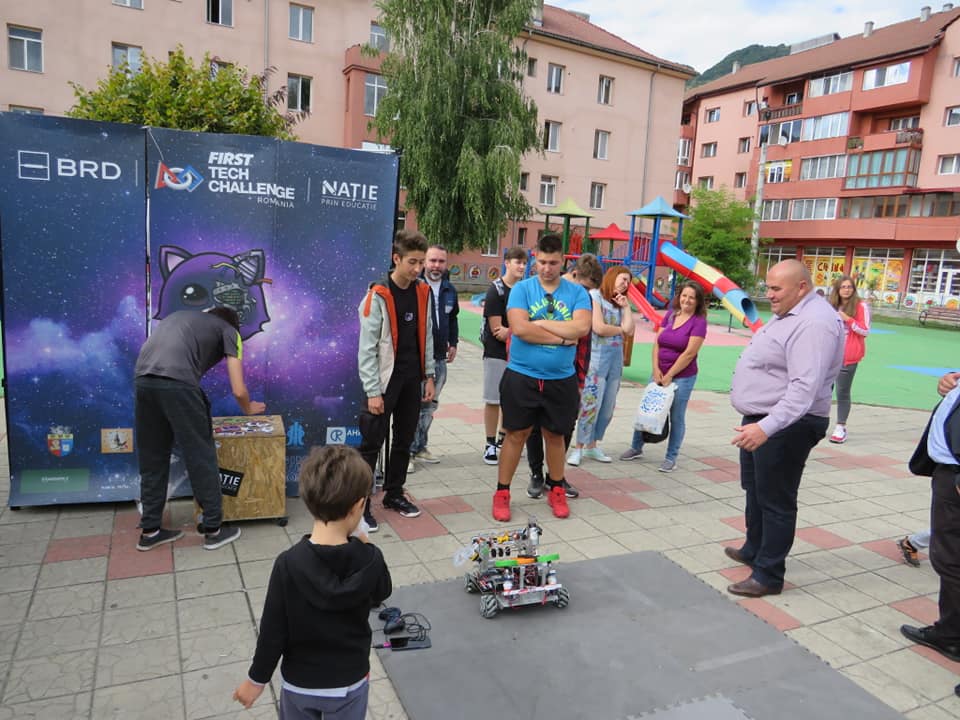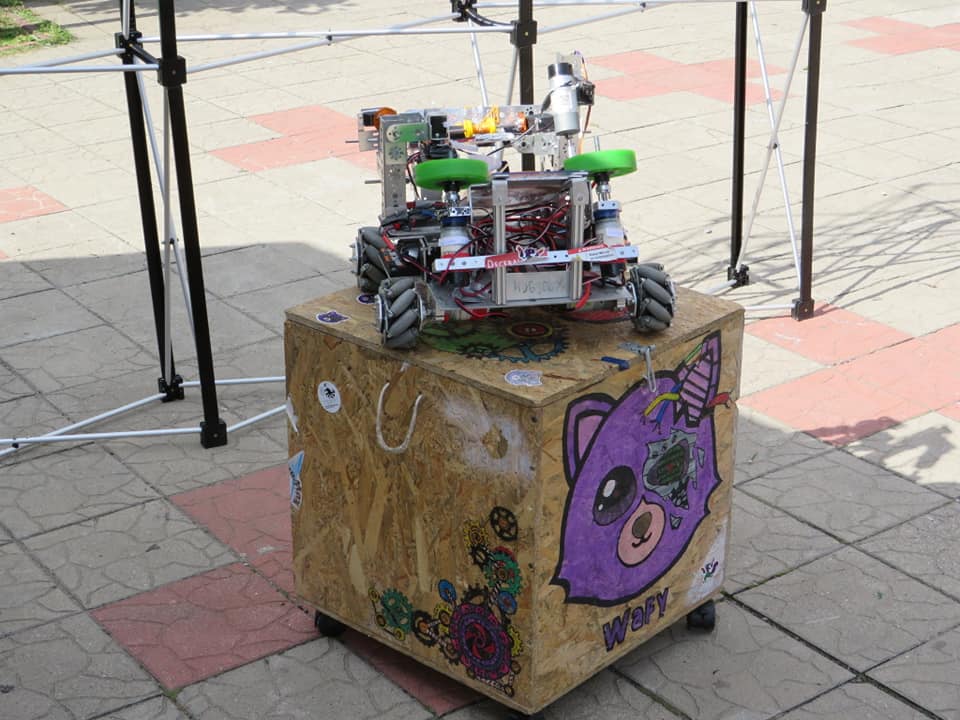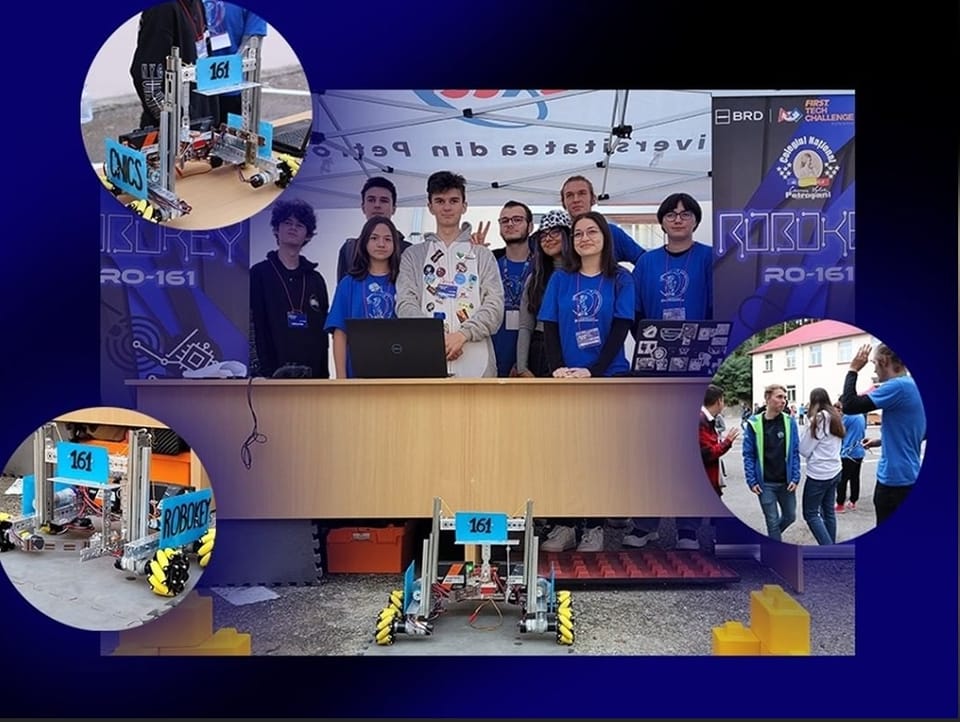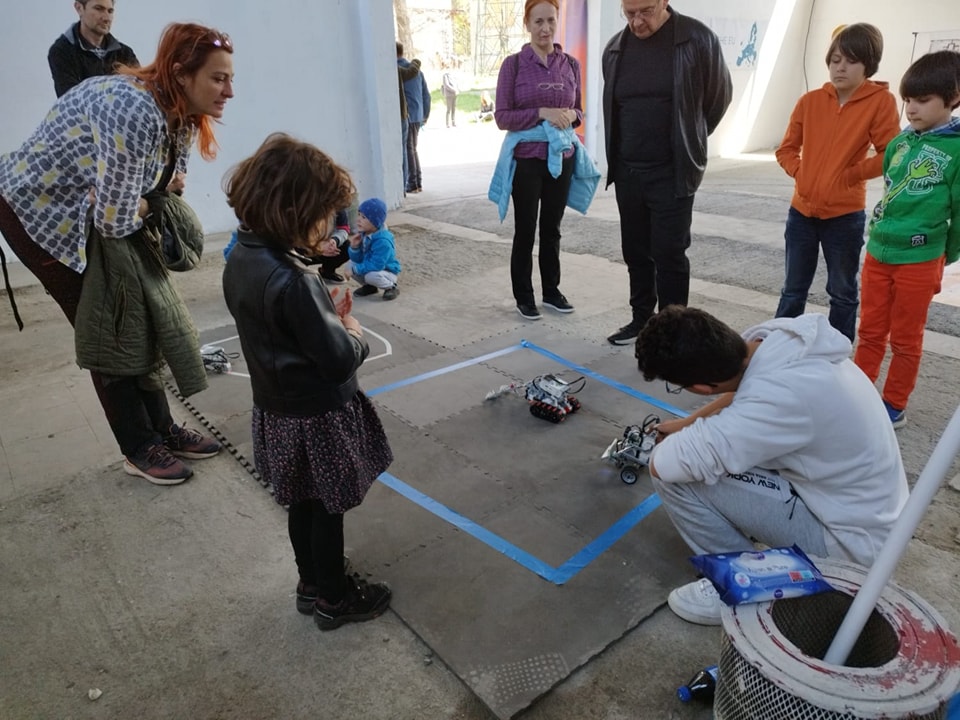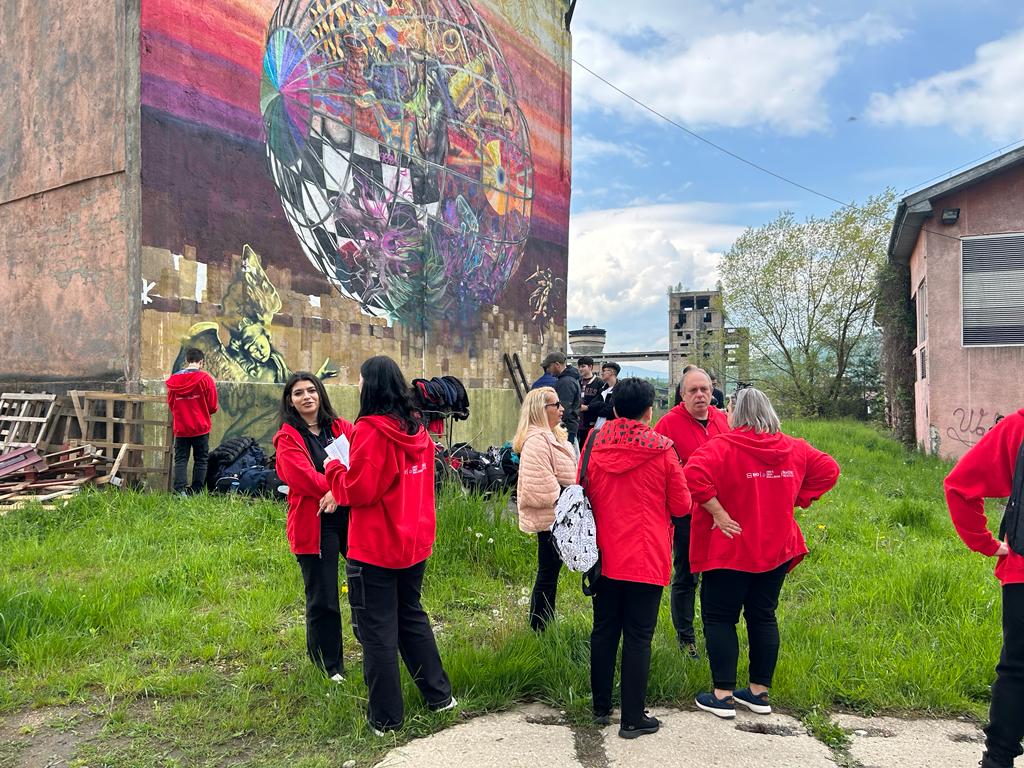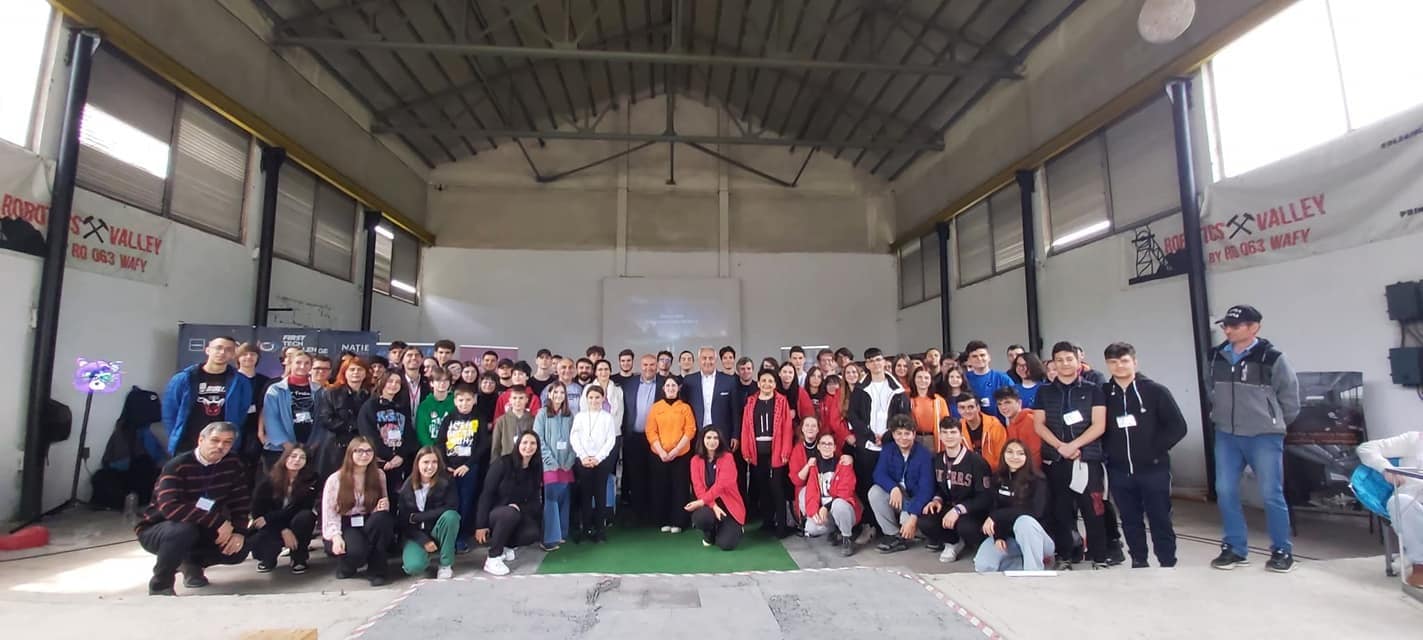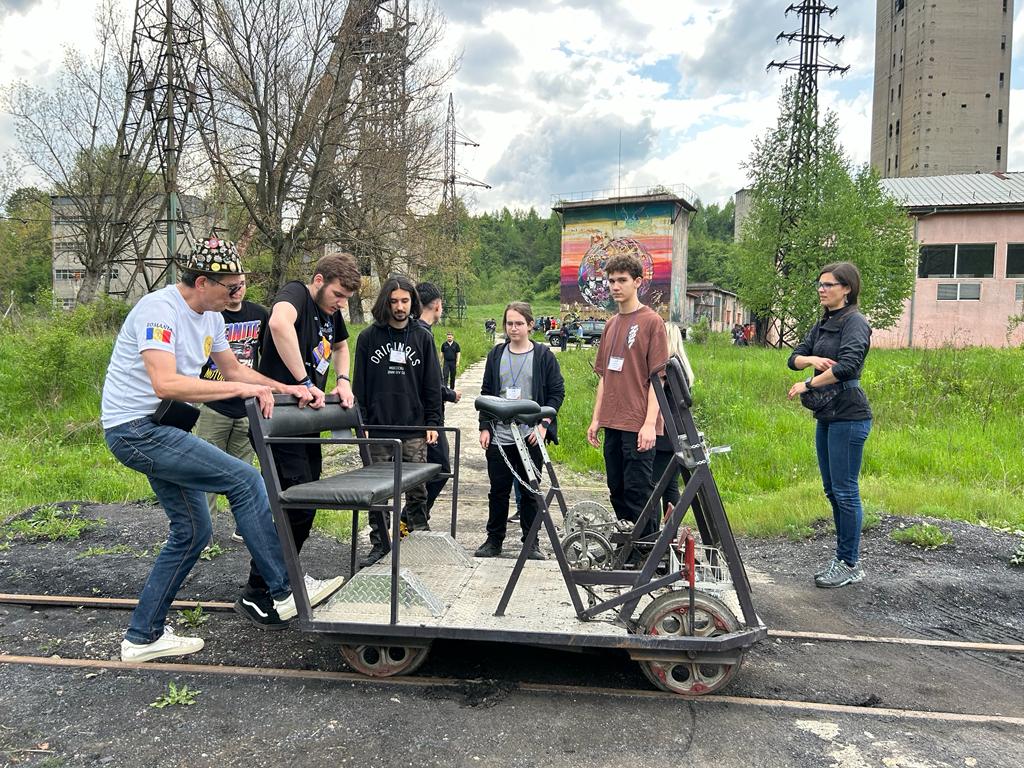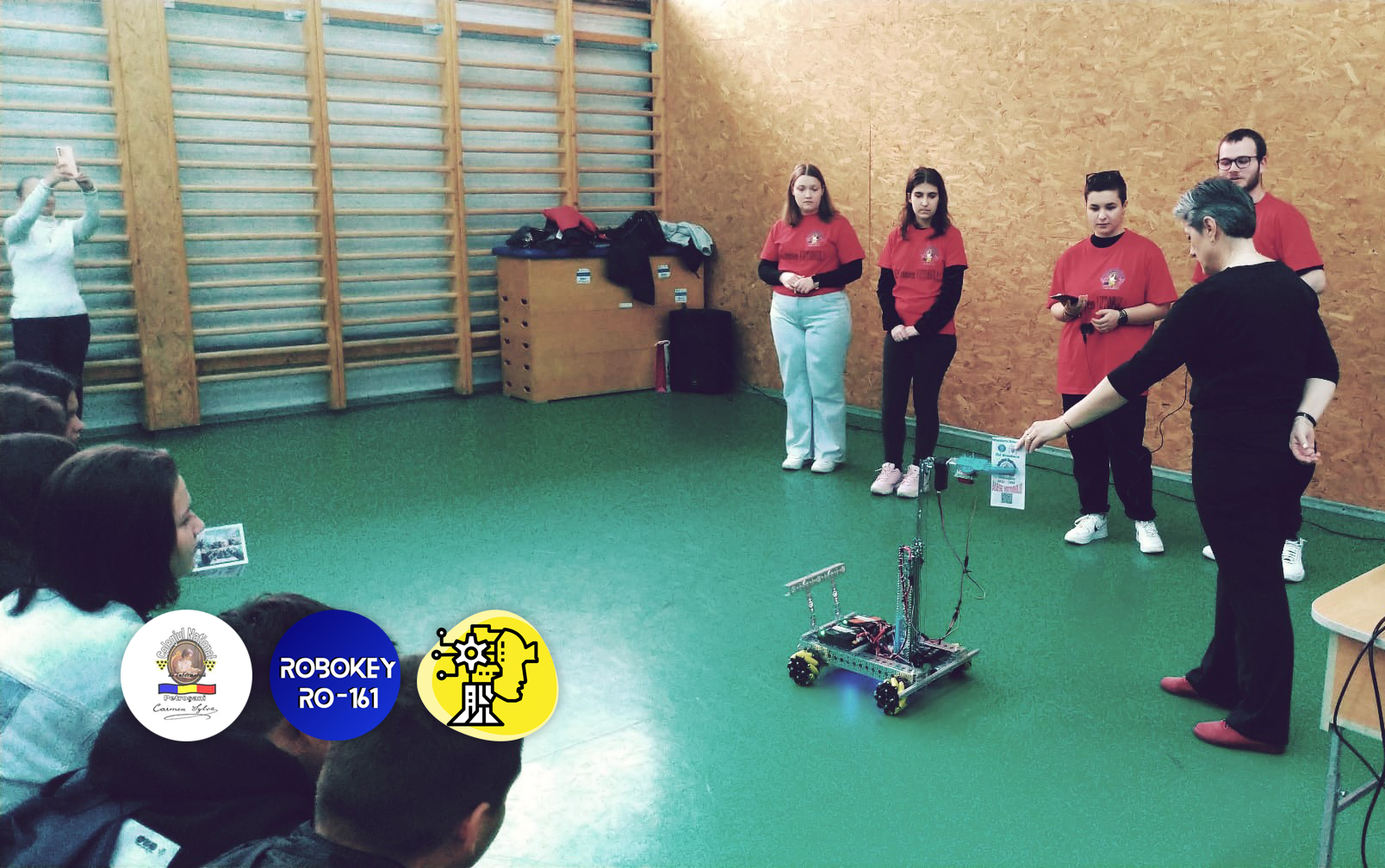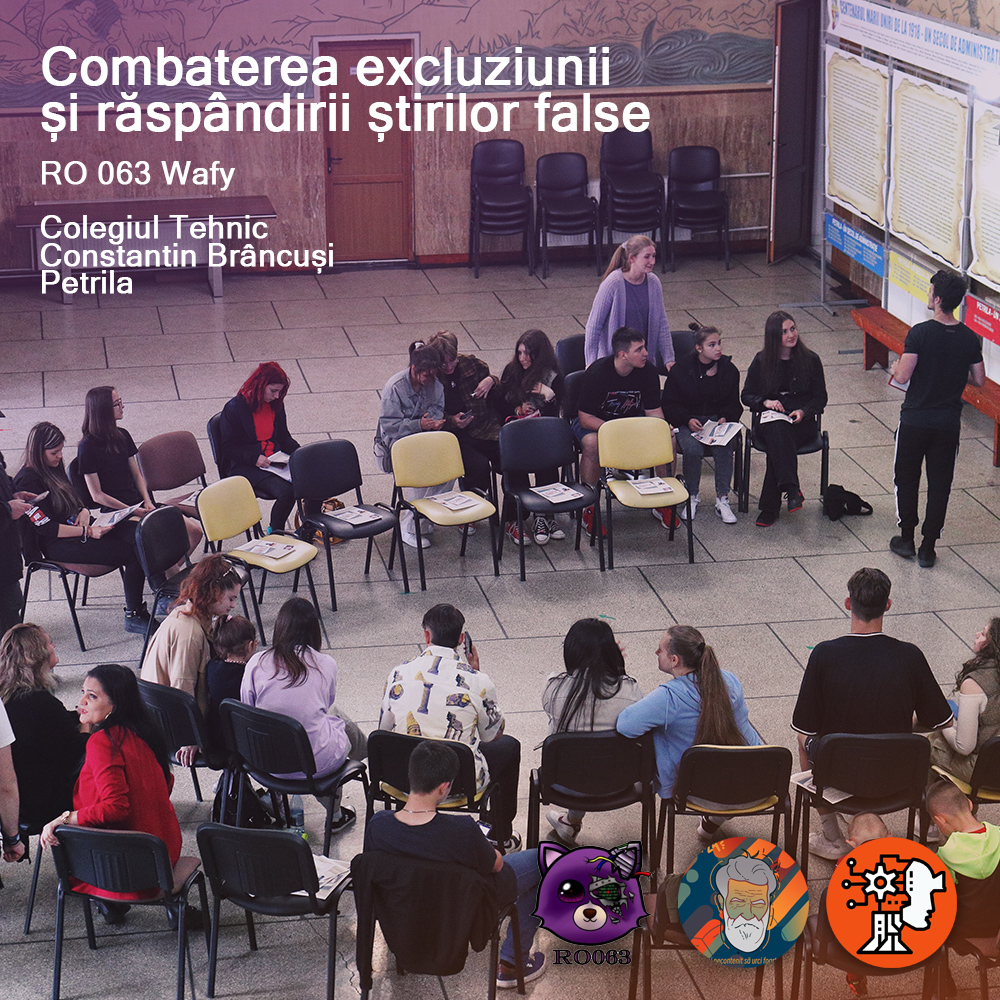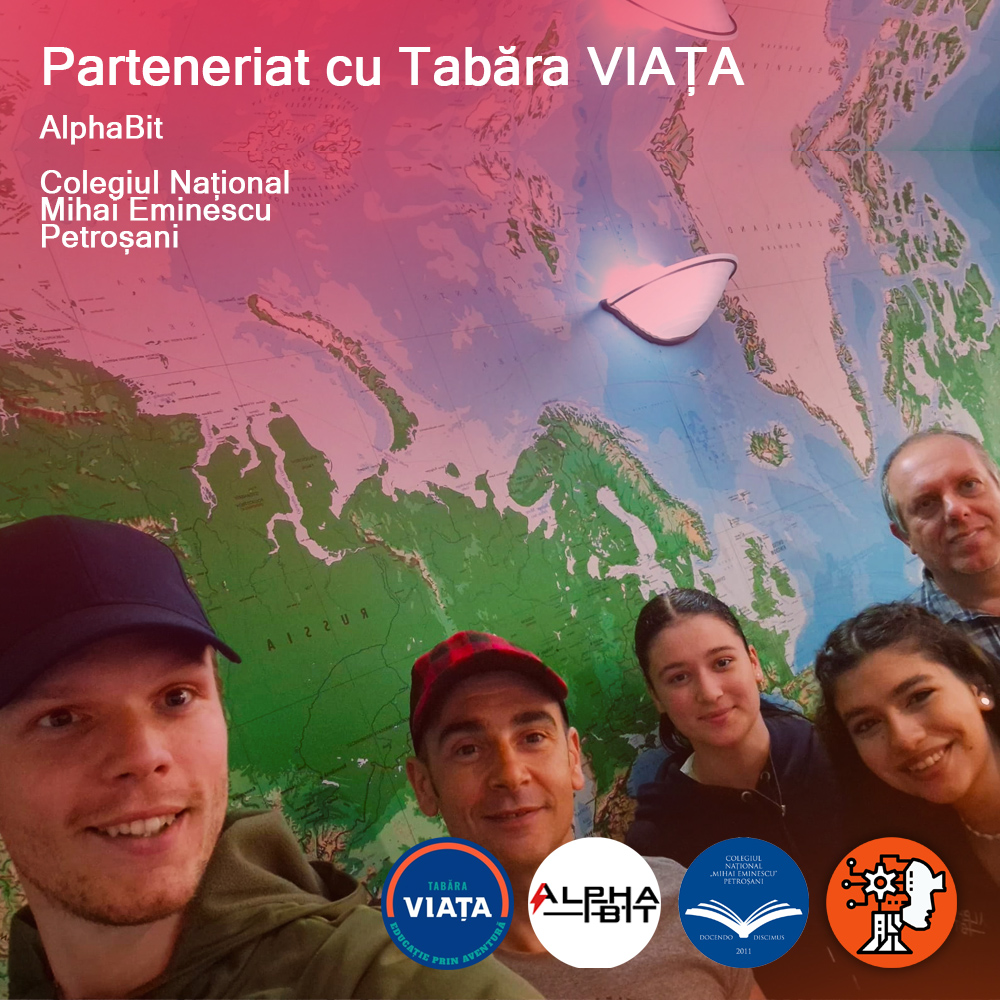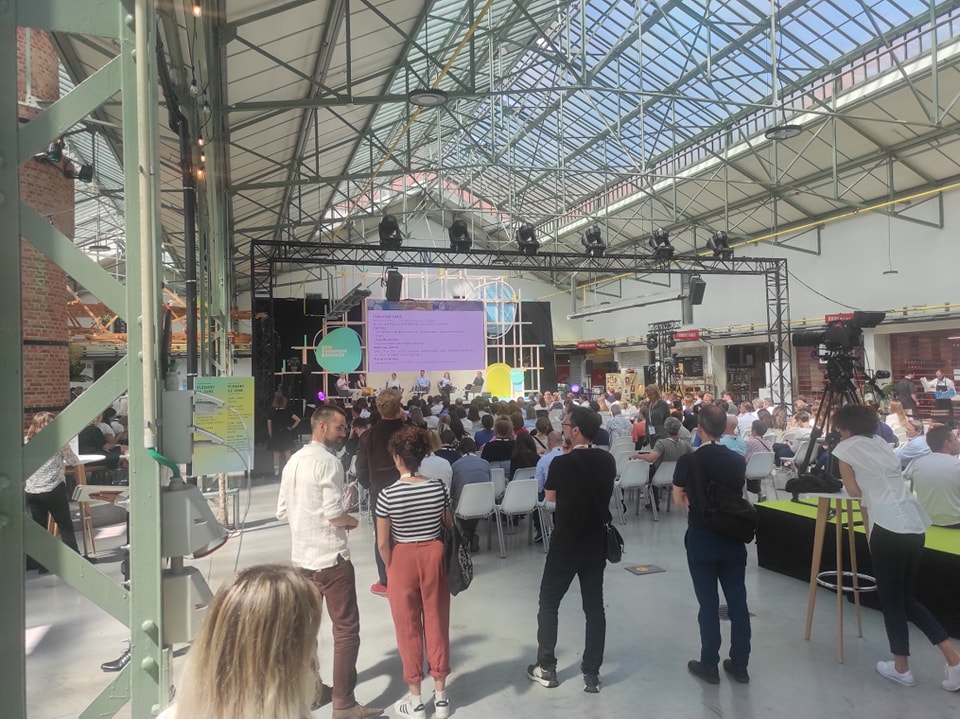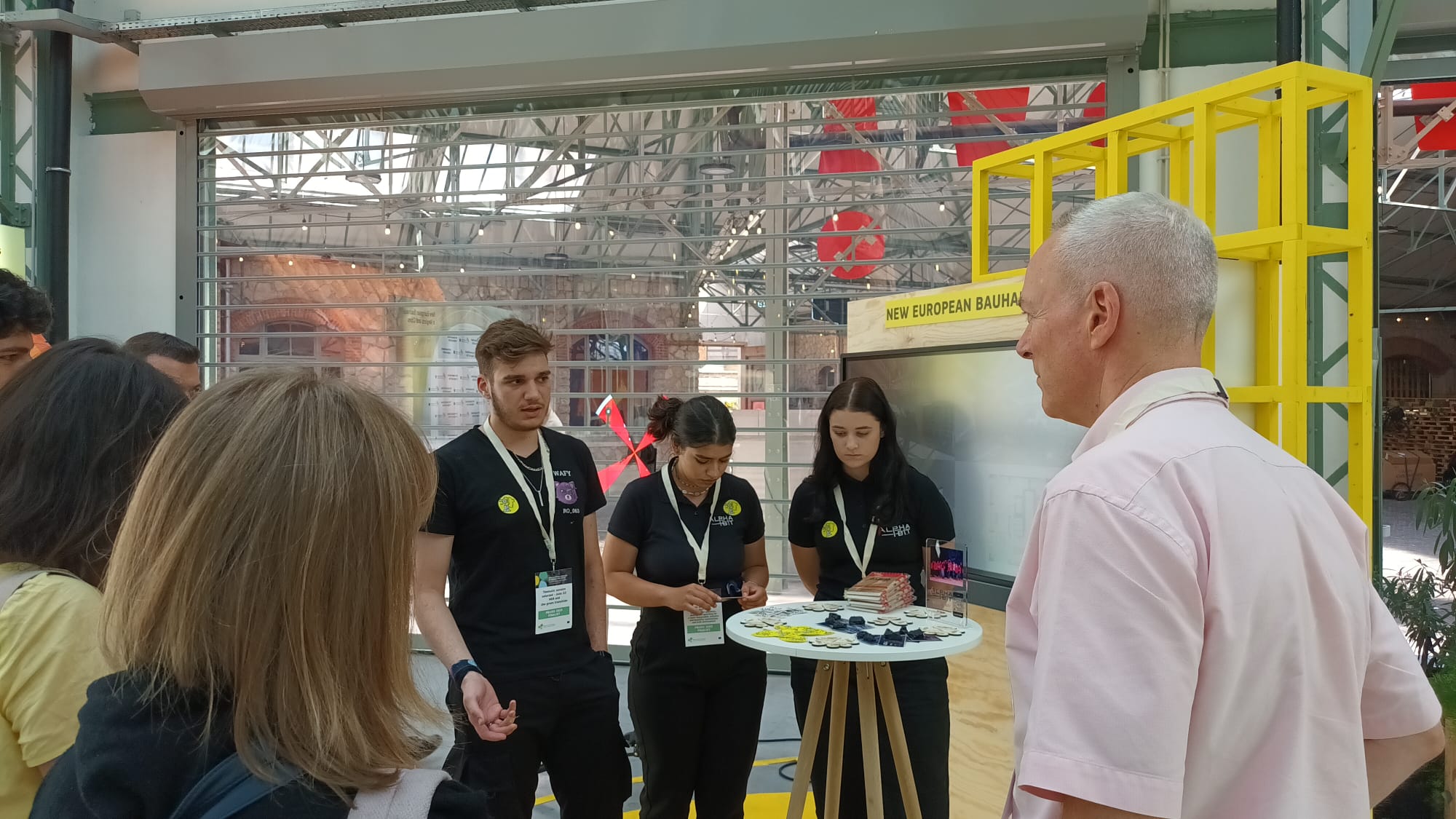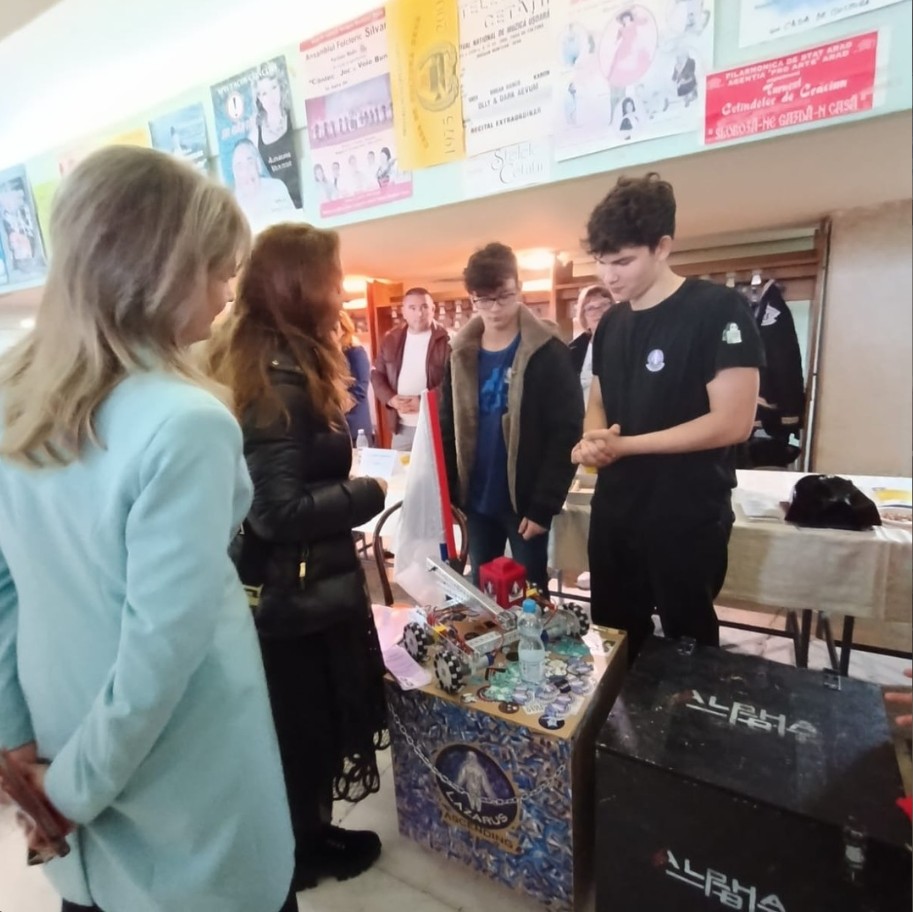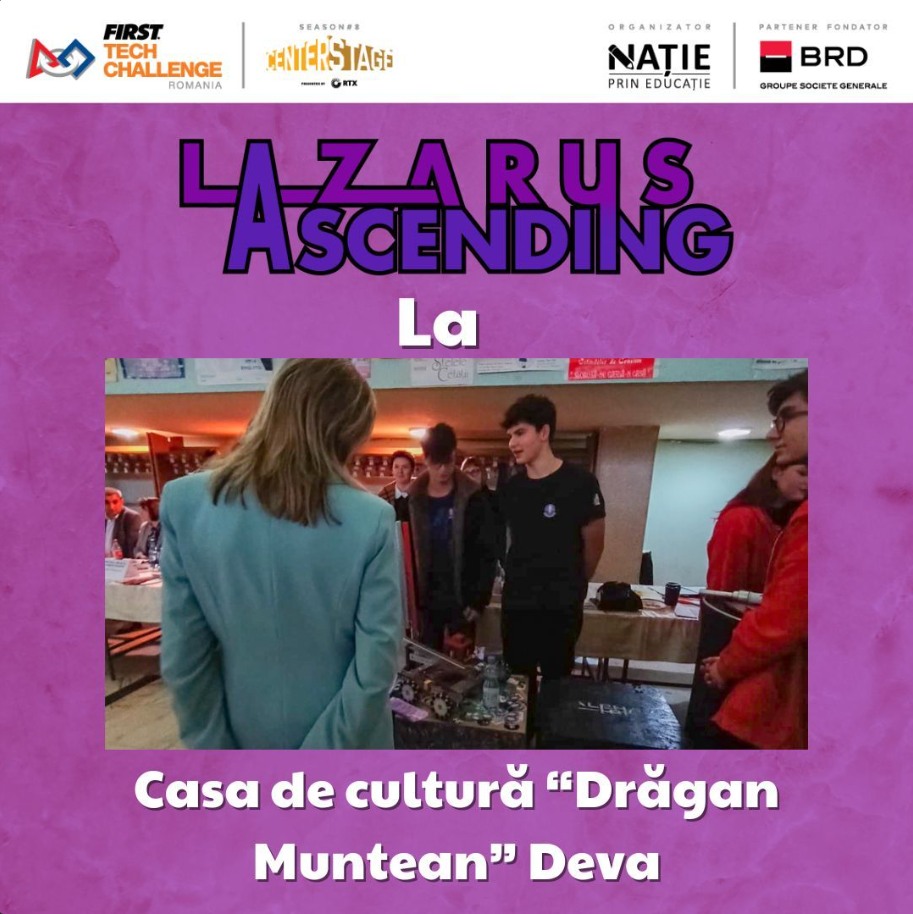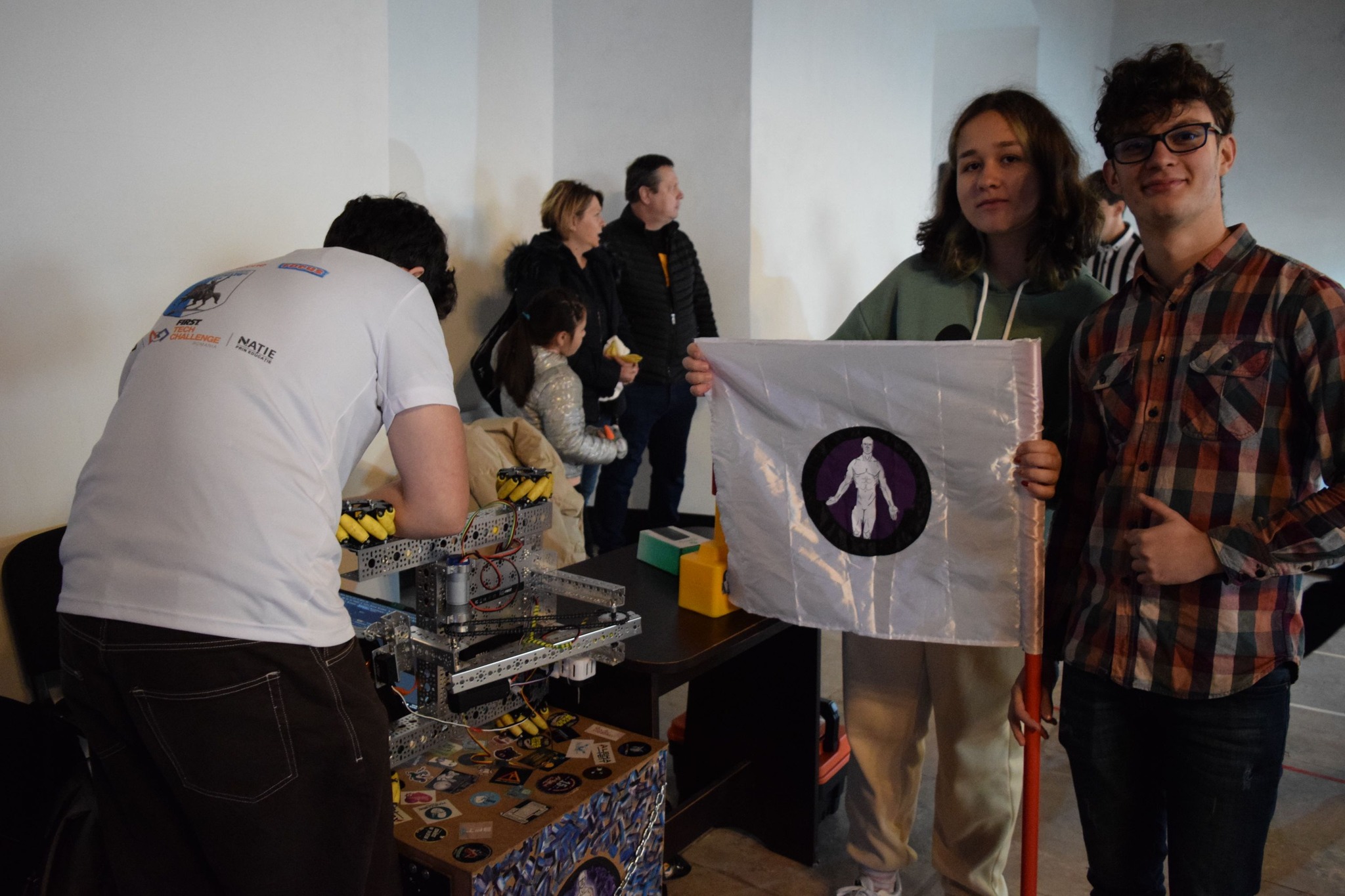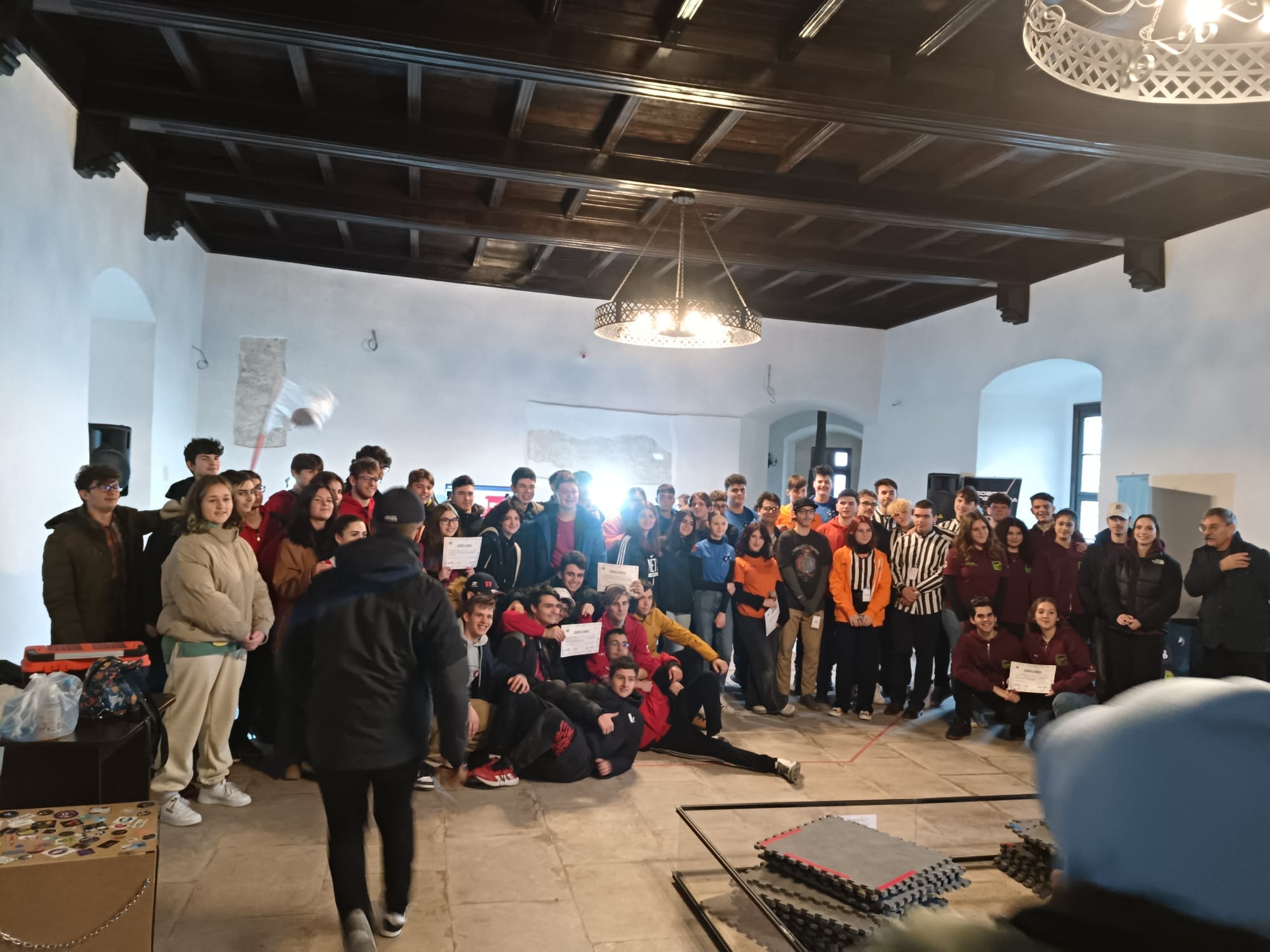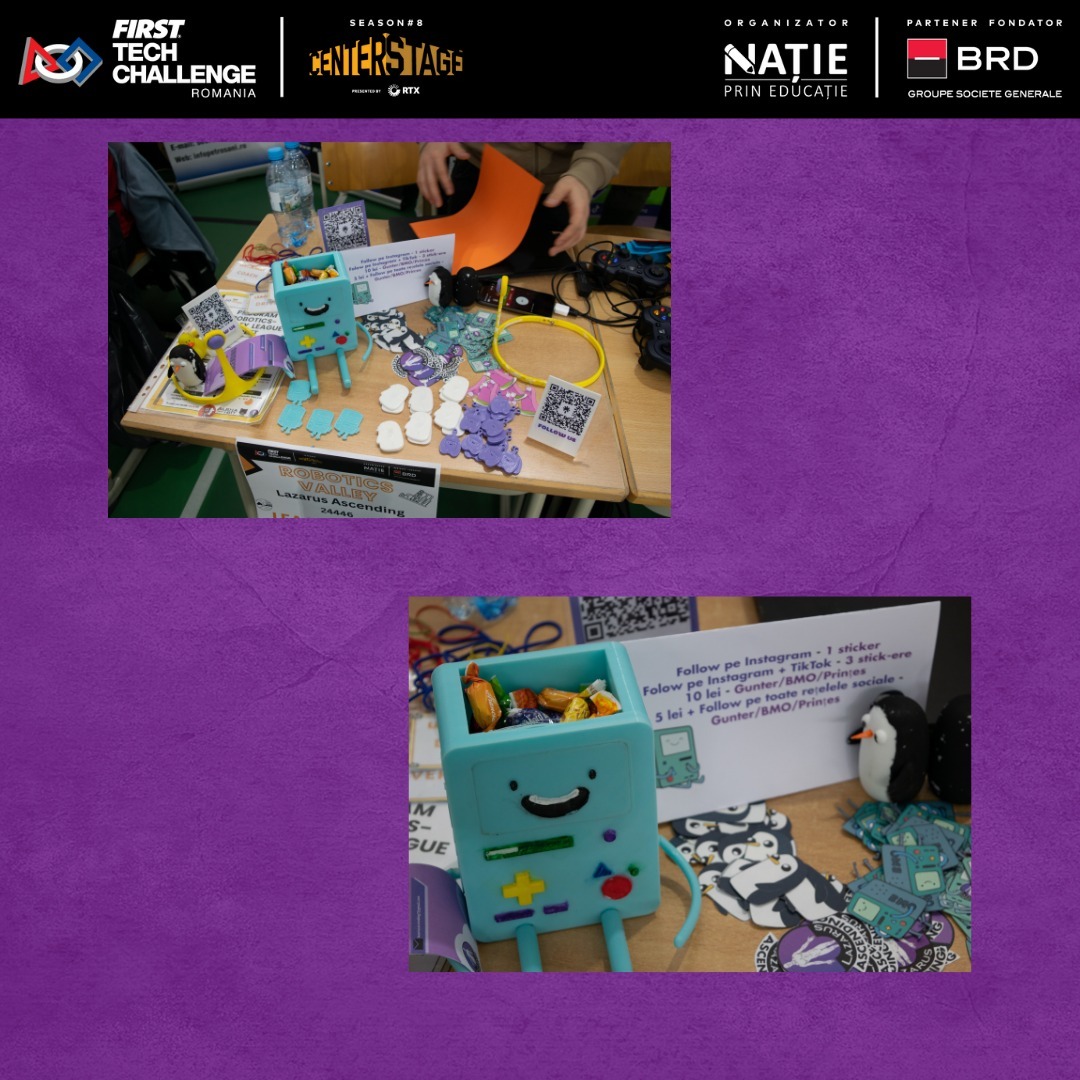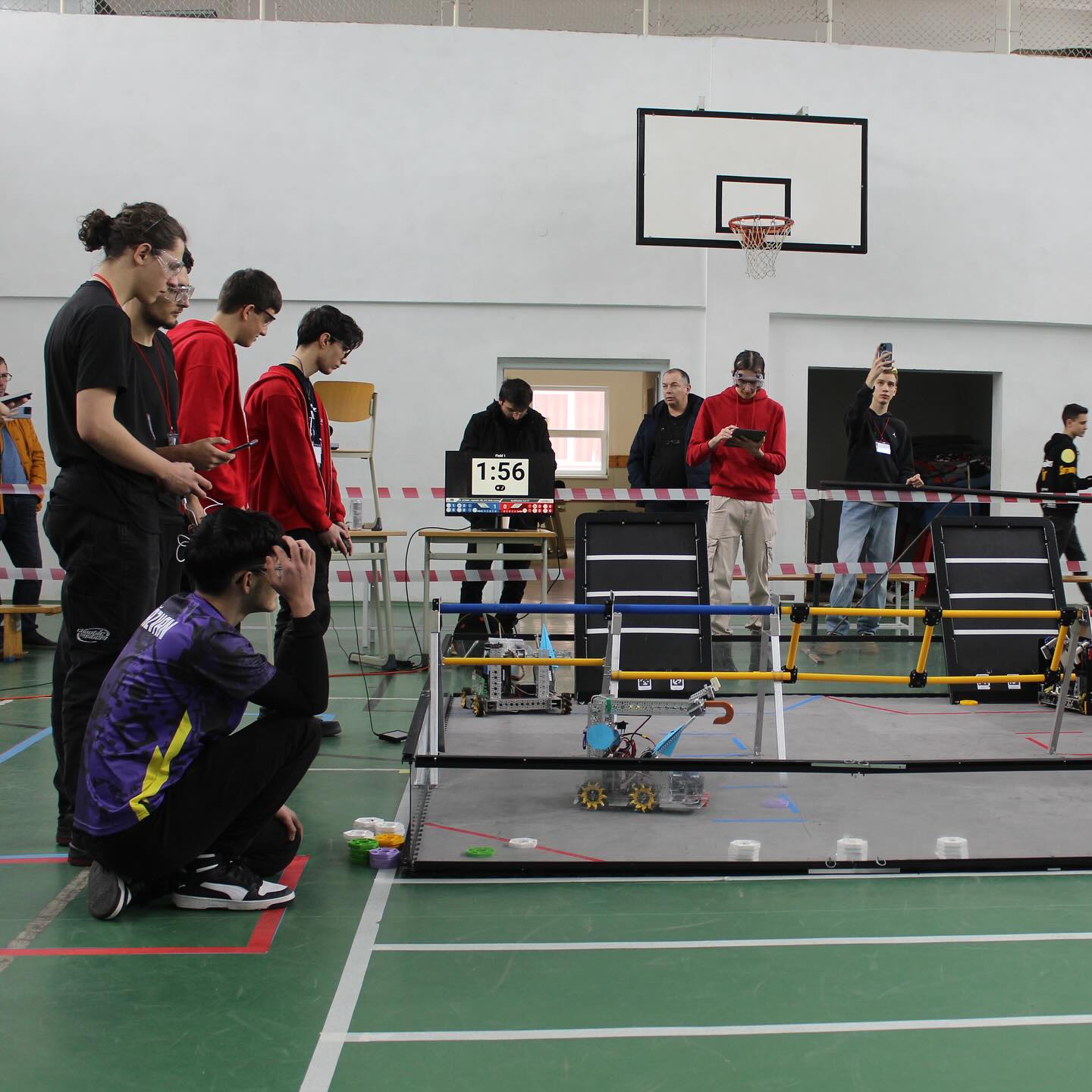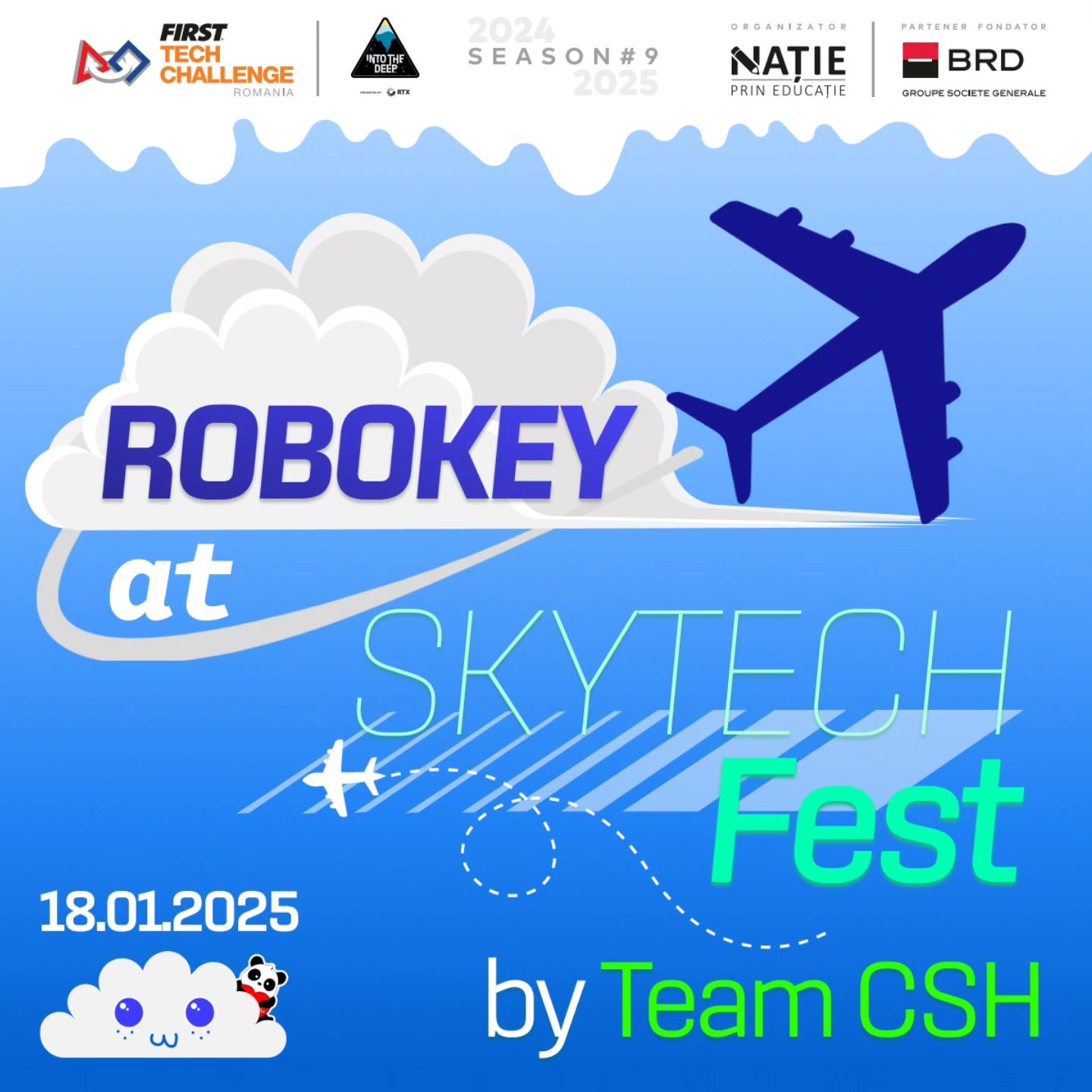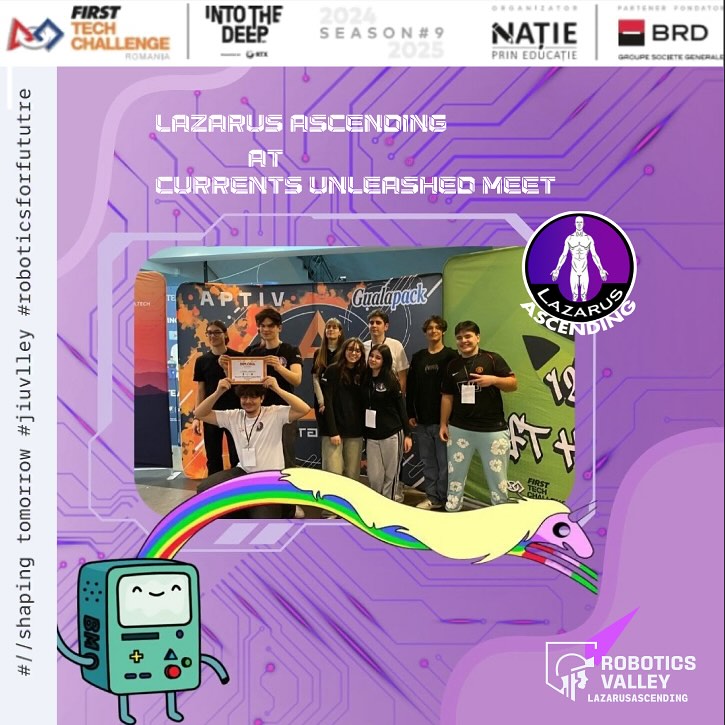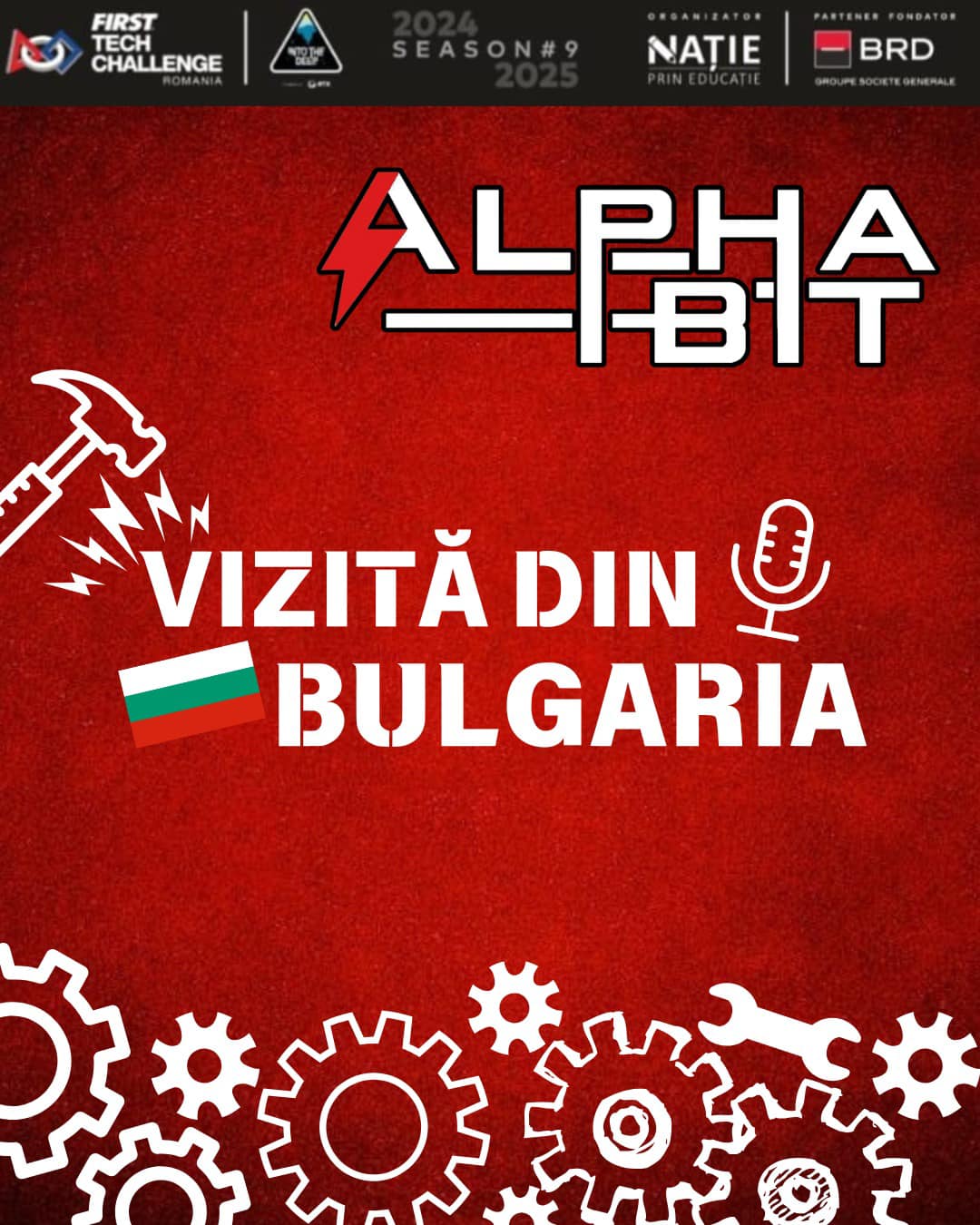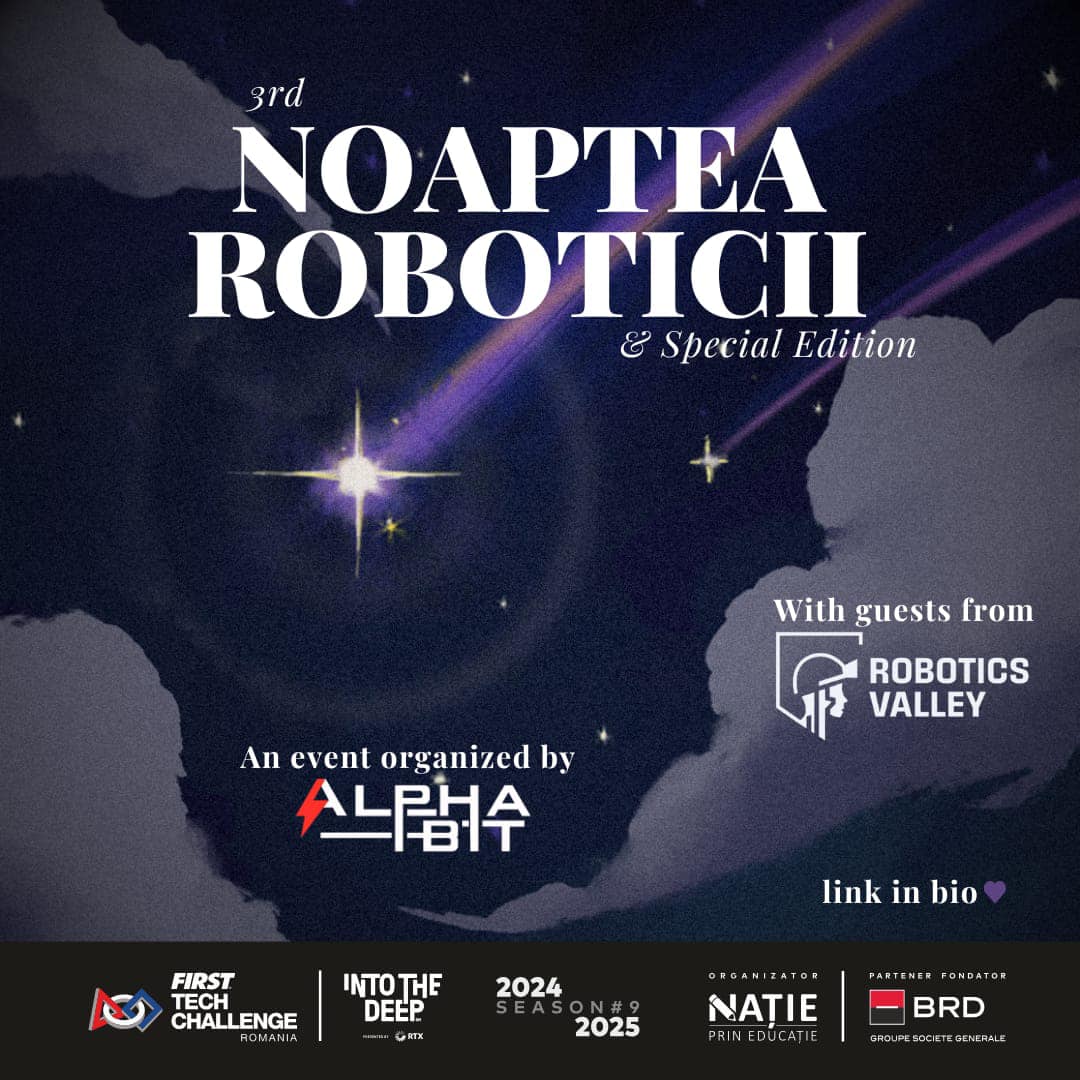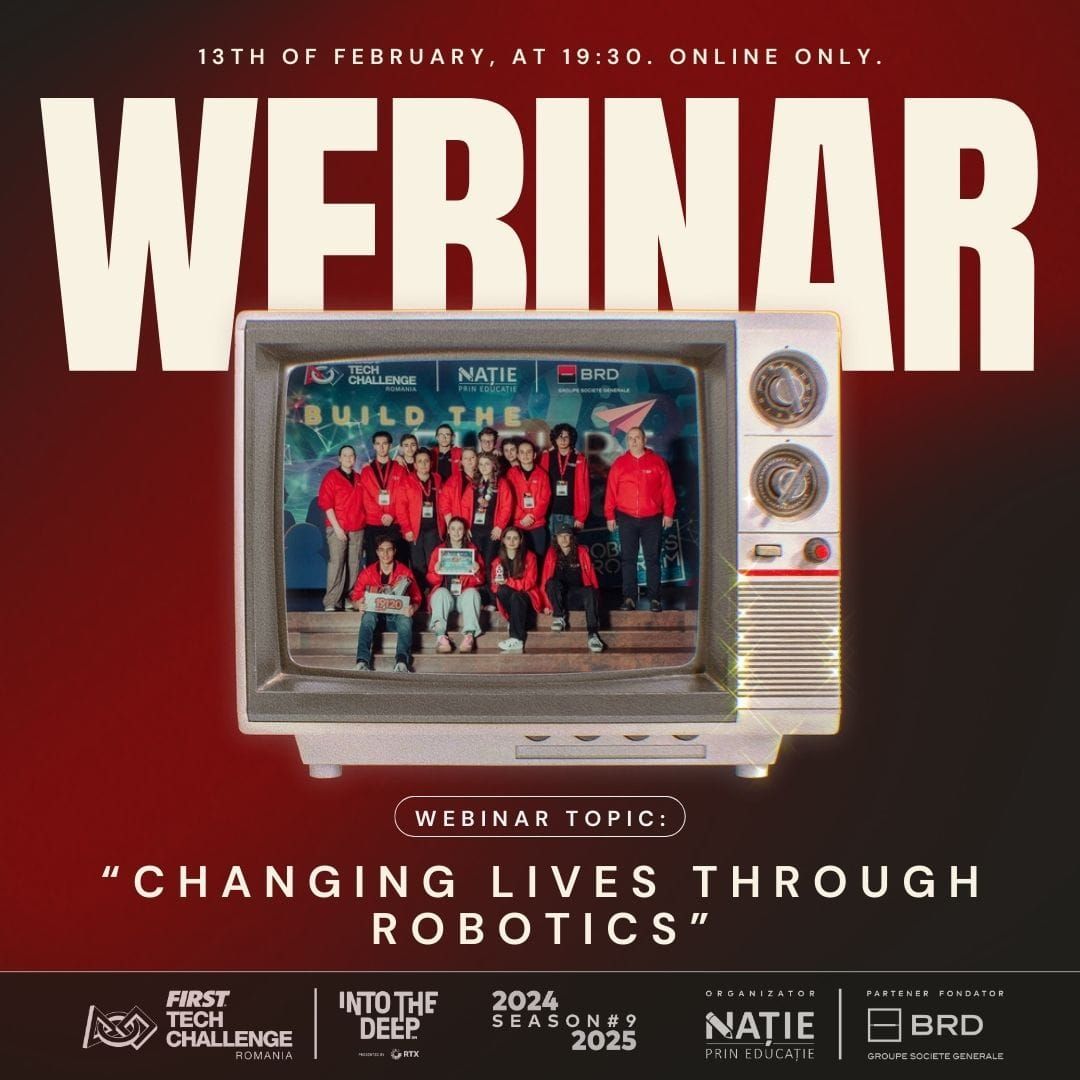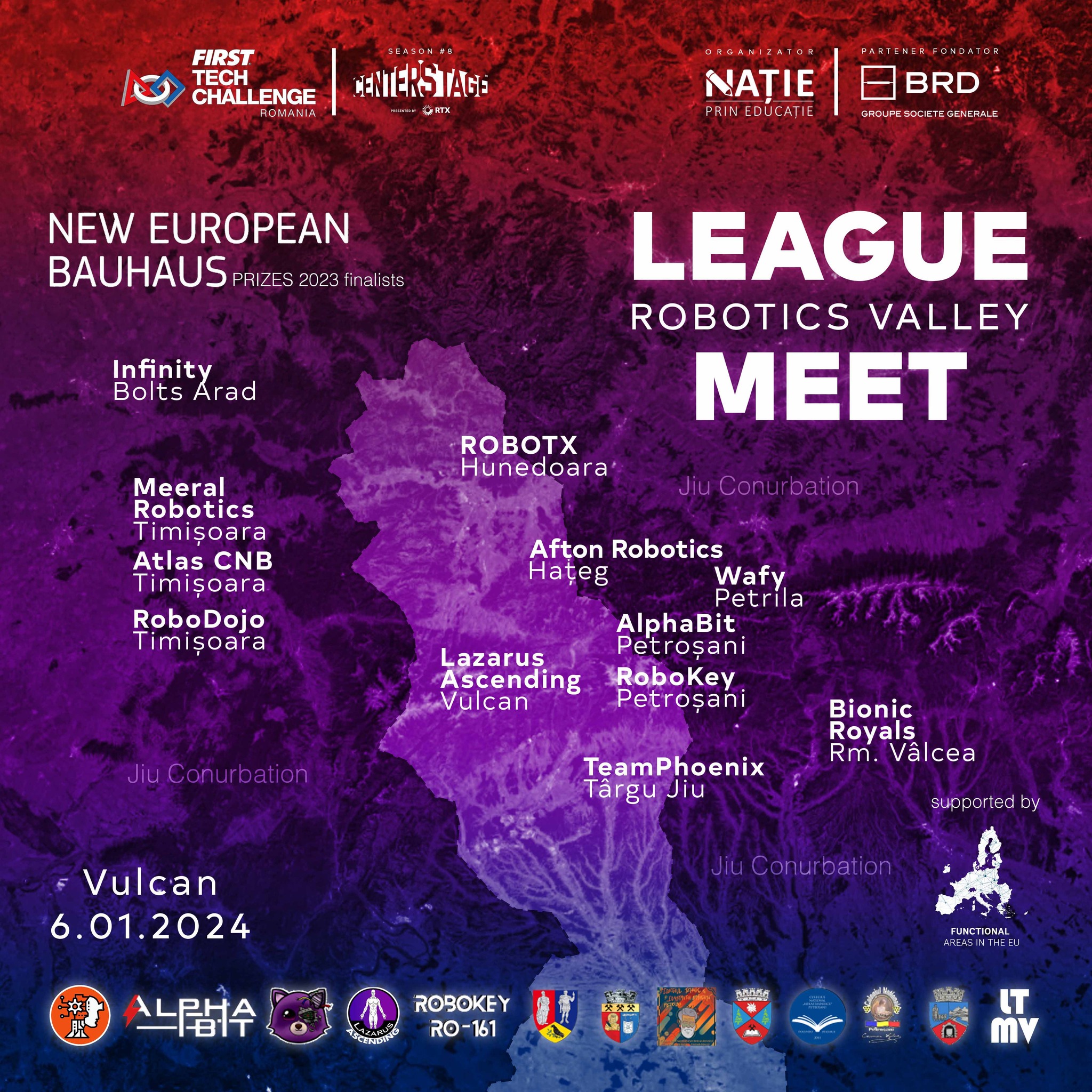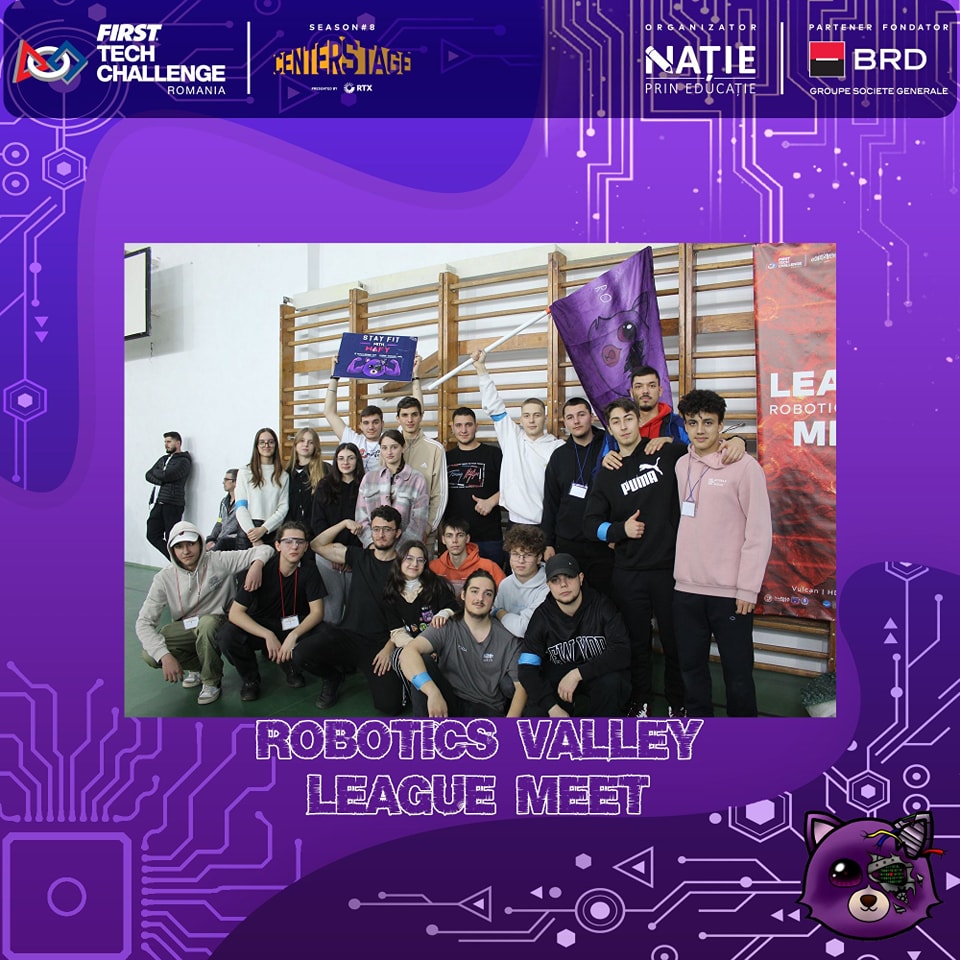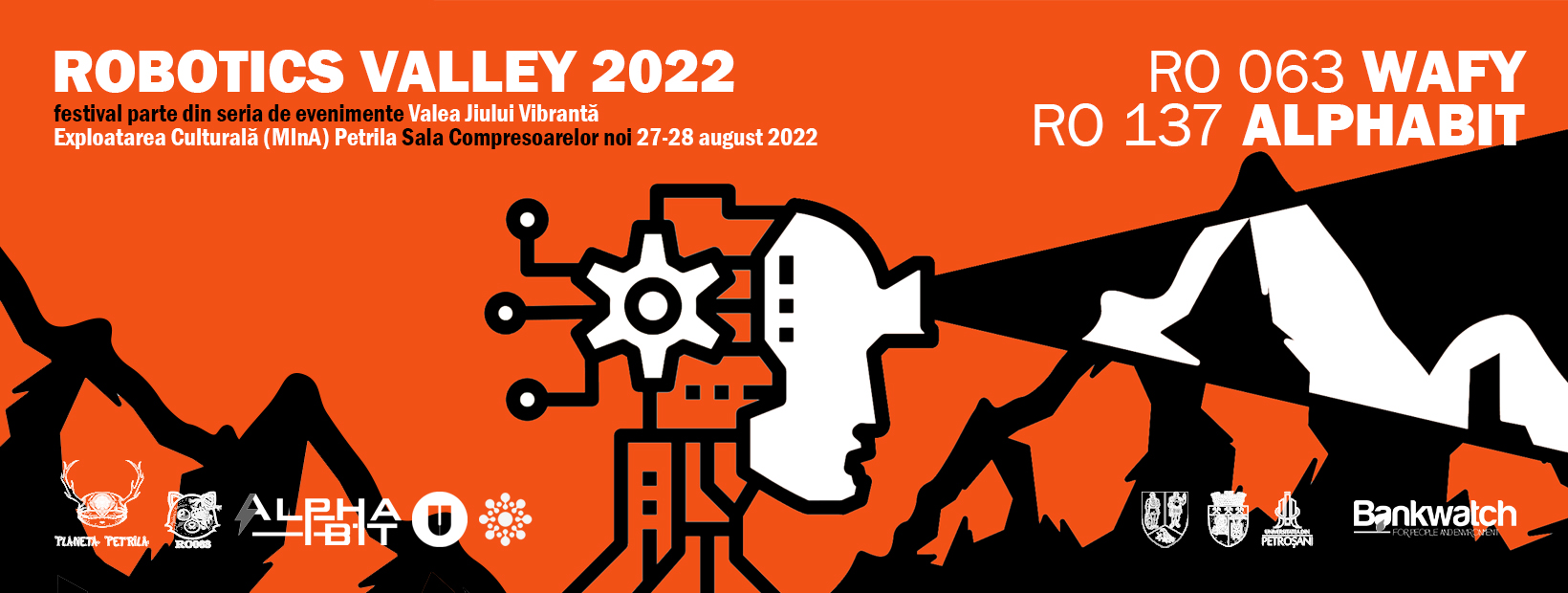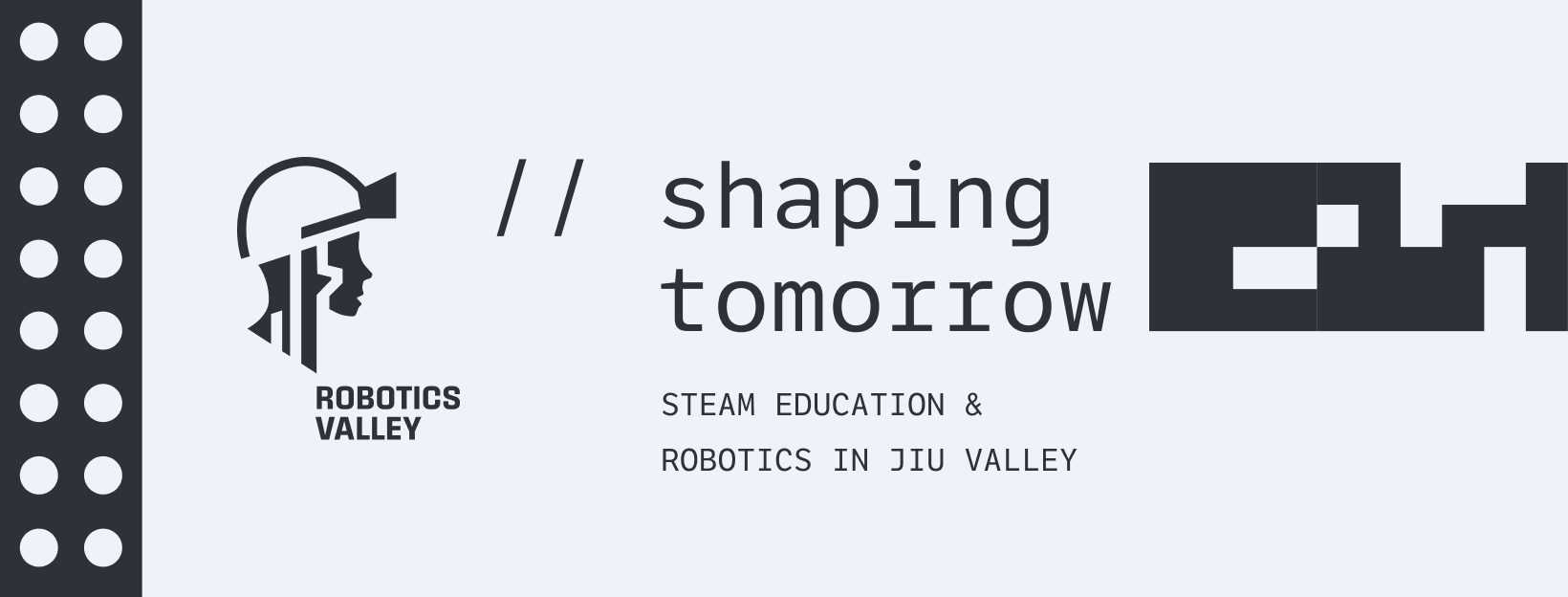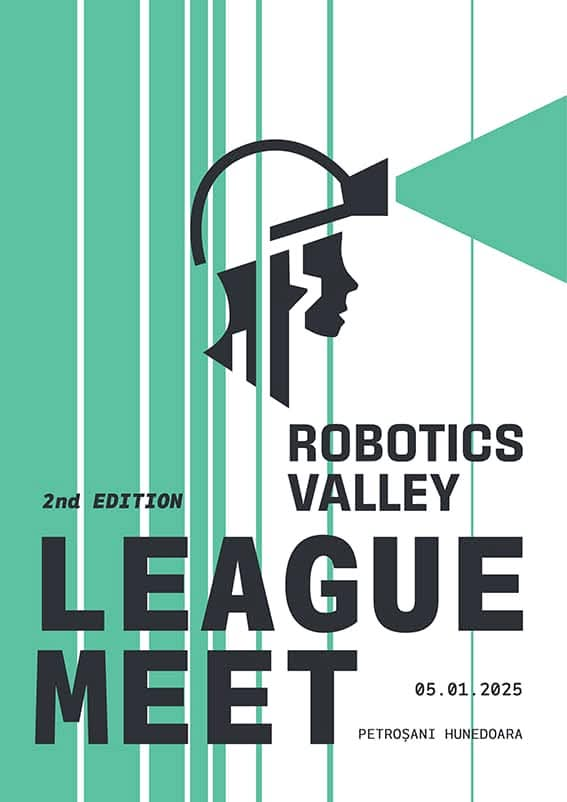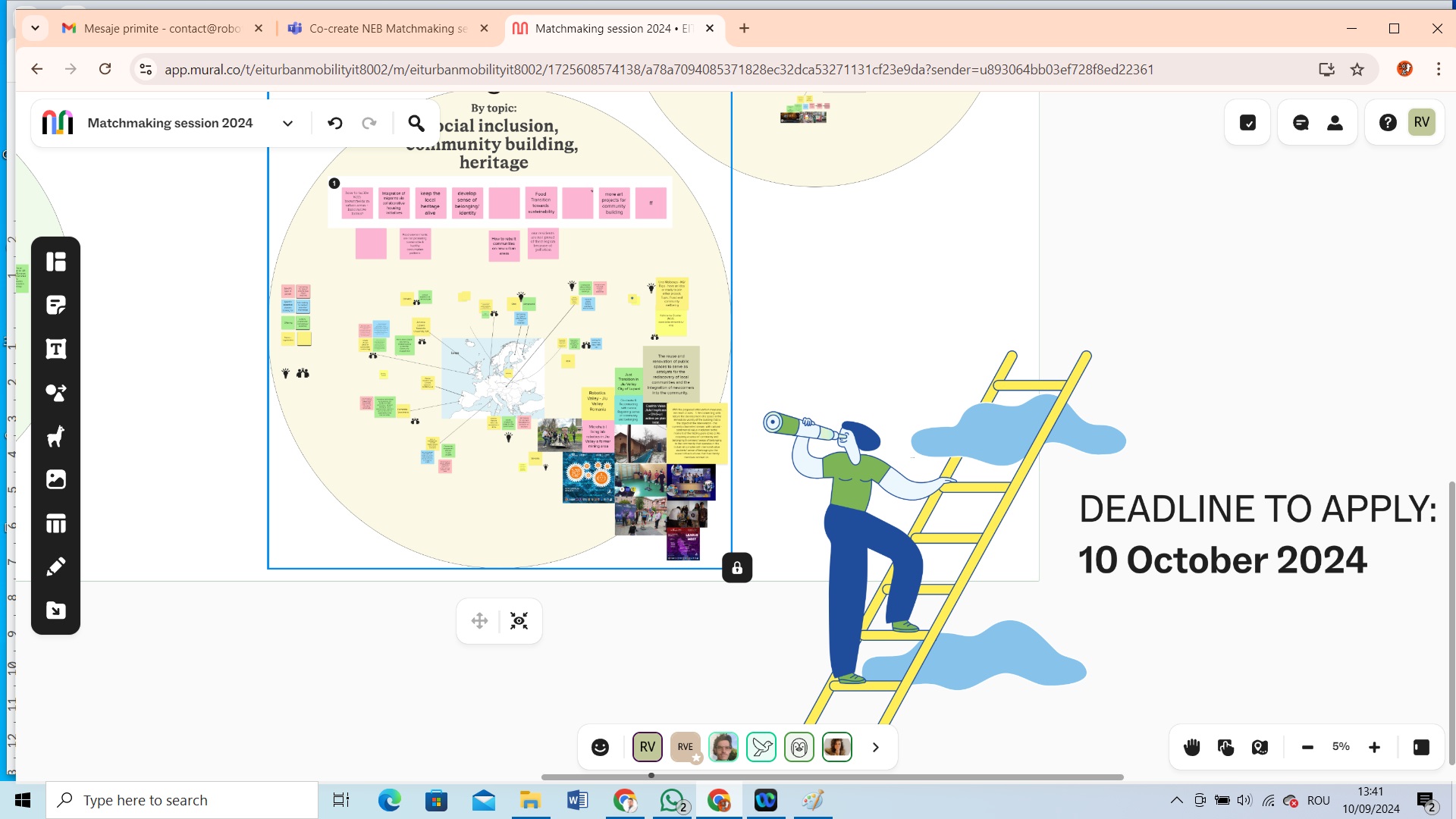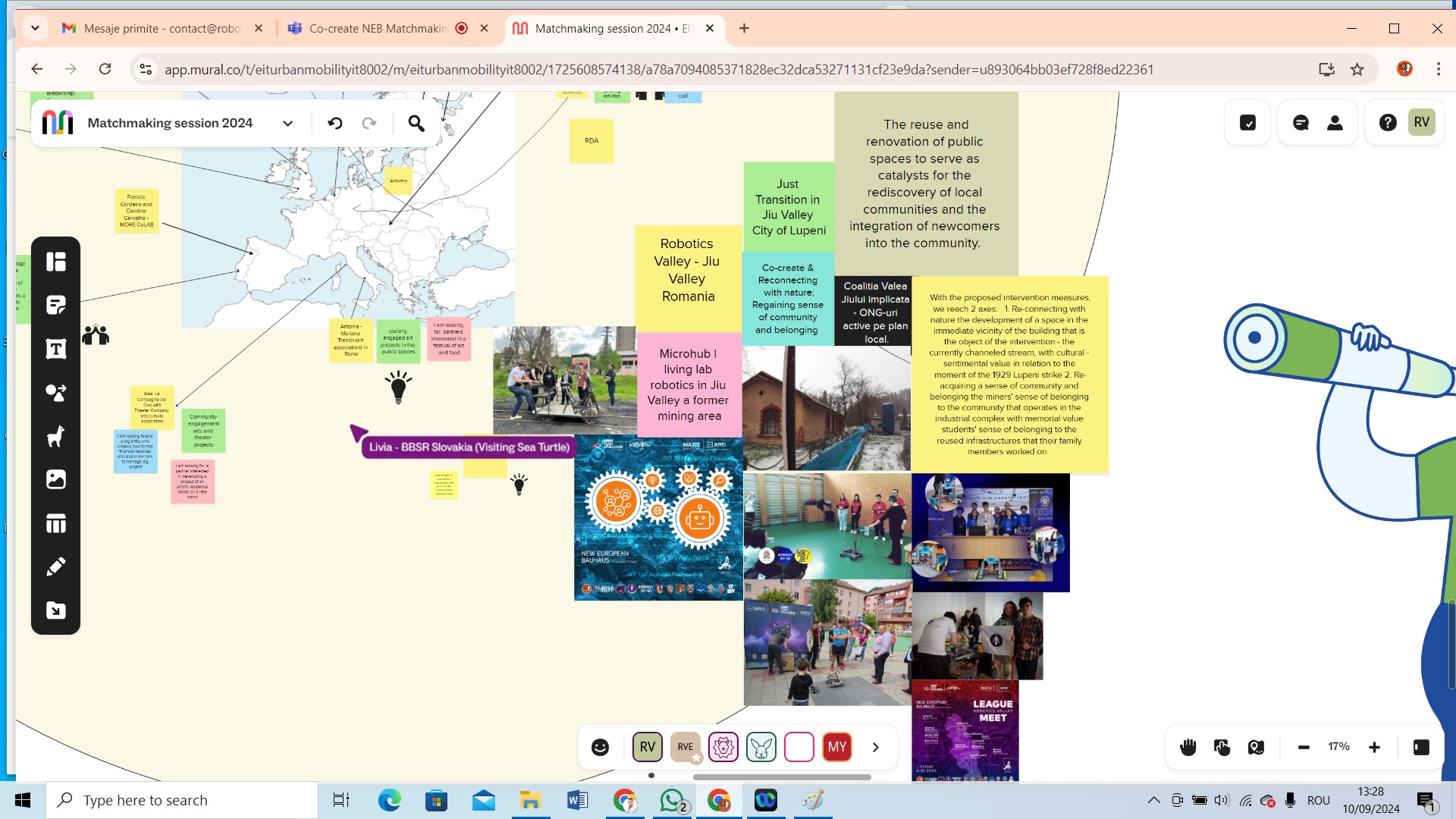Prioritising the places and people that need it the most
Robotics Valley
Robotics Valley - The Hub, sustainable skills for a NEB future
Robotics Valley, from 2019 to present aims to be an innovative social venture. Our students who drive their robots, are emerging as rising stars on the path of the region's Just Transition. By aligning local resources with NEB principles and promoting a participatory approach, by and for high school students, it embraces a multidisciplinary perspective focused on robotics. This enables students to create local solutions to global challenges and catalyze the change inspired by the Jiu Valley NEB.
Romania
Regional
Vest Region - Hunedoara County - Jiu Valley microregion.
It addresses urban-rural linkages
It refers to other types of transformations (soft investment)
Early concept
No
No
As an individual partnership with other persons/organisation(s)
Robotics Valley (RV) aims to inspire and empower students in Jiu Valley Romania - a region facing significant socio-economic challenges due to the closure of local coal mines. Targeting young people aged 14 to 18, the initiative provides modern education in robotics, equipping them with technical and multidisciplinary skills essential for future careers. The overarching aim is to foster an inclusive and sustainable future by preparing the next generation for opportunities in the green economy.
A key objective is to repurpose part of the industrial heritage at former Petrila Mine into a state-of-the-art Robotics Hub. This facility serves as an advanced learning environment, preserving cultural heritage while equipping students with skills relevant to emerging industries. Additionally, the hub aims to stimulate local economic growth by nurturing a highly skilled workforce and attracting new investment to the region.
Since its inception in 2019, RV has successfully connected and supported 5 local robotics teams, engaging over 100 students in national competitions and regional events. Notable achievements include hosting three League Meet programmes at Petrila Mine and establishing the Robotics Valley Association (ARV) to provide a formal structure for the initiative’s expansion. Educational activities include artistic interventions, financial literacy workshops & intergenerational collaborations with the University of Petroșani & local NGOs.
The project aligns with the principles of the NEB, with a focus on sustainability, inclusive design & entrepreneurship. By involving students in designing robotic solutions that address community needs, RV not only enhances their skills but also contributes to the revitalization of the local economy. Through strategic partnerships with local authorities and stakeholders, the initiative empowers young people to become agents of change in their community, positioning them as rising stars in innovation and sustainable development.
A key objective is to repurpose part of the industrial heritage at former Petrila Mine into a state-of-the-art Robotics Hub. This facility serves as an advanced learning environment, preserving cultural heritage while equipping students with skills relevant to emerging industries. Additionally, the hub aims to stimulate local economic growth by nurturing a highly skilled workforce and attracting new investment to the region.
Since its inception in 2019, RV has successfully connected and supported 5 local robotics teams, engaging over 100 students in national competitions and regional events. Notable achievements include hosting three League Meet programmes at Petrila Mine and establishing the Robotics Valley Association (ARV) to provide a formal structure for the initiative’s expansion. Educational activities include artistic interventions, financial literacy workshops & intergenerational collaborations with the University of Petroșani & local NGOs.
The project aligns with the principles of the NEB, with a focus on sustainability, inclusive design & entrepreneurship. By involving students in designing robotic solutions that address community needs, RV not only enhances their skills but also contributes to the revitalization of the local economy. Through strategic partnerships with local authorities and stakeholders, the initiative empowers young people to become agents of change in their community, positioning them as rising stars in innovation and sustainable development.
skills
robotics
education
interdisciplinary
sustainability
RV supports the just transition of the Jiu Valley from a coal-dependent economy to a sustainable, green future by equipping local students with essential sustainability skills. Building on the foundations laid by Petrila Technic College & Petroșani National College, the initiative engages high school students in robotics, fostering their capacity to lead this change. The project focuses on sustainability education, adaptive reuse of industrial heritage, and environmental stewardship, making it a model for sustainable development.
A key objective is to equip students with sustainability skills such as critical thinking, systemic thinking, and collective action. Through robotics and financial education, students learn to address community challenges with a sustainability mindset. The context of Just Transition also promotes values of fairness, problem-solving&future literacy, empowering students to contribute to a sustainable economy.
Environmental sustainability was prioritized throughout the initiative. Events were designed to minimize environmental impact, focusing on reducing energy consumption and waste. 3 of the 5 editions of RV were hosted at Petrila Mine, where abandoned mining structures were revitalized for educational purposes. This adaptive reuse preserved cultural heritage and demonstrated the potential of repurposing existing infrastructure. Additionally, robots developed during the program, such as the air quality measurement kit, were designed with sustainability in mind.
A key achievement is the creation of the Robotics Hub at Petrila Mine, showcasing adaptive reuse as a model for sustainable development. The Hub follows principles of nZEB building circularity, positive energy, and recycling, ensuring a minimal environmental footprint. Following this, similar projects are planned for Lonea & Lupeni, expanding the initiative’s impact across the Jiu Valley. Robotics Valley equips youth with sustainability skills, advancing the green economy.
A key objective is to equip students with sustainability skills such as critical thinking, systemic thinking, and collective action. Through robotics and financial education, students learn to address community challenges with a sustainability mindset. The context of Just Transition also promotes values of fairness, problem-solving&future literacy, empowering students to contribute to a sustainable economy.
Environmental sustainability was prioritized throughout the initiative. Events were designed to minimize environmental impact, focusing on reducing energy consumption and waste. 3 of the 5 editions of RV were hosted at Petrila Mine, where abandoned mining structures were revitalized for educational purposes. This adaptive reuse preserved cultural heritage and demonstrated the potential of repurposing existing infrastructure. Additionally, robots developed during the program, such as the air quality measurement kit, were designed with sustainability in mind.
A key achievement is the creation of the Robotics Hub at Petrila Mine, showcasing adaptive reuse as a model for sustainable development. The Hub follows principles of nZEB building circularity, positive energy, and recycling, ensuring a minimal environmental footprint. Following this, similar projects are planned for Lonea & Lupeni, expanding the initiative’s impact across the Jiu Valley. Robotics Valley equips youth with sustainability skills, advancing the green economy.
Despite Jiu Valley’s natural beauty, its industrial legacy, marked by decaying buildings and abandoned mines, creates a somber visual impression. While the robotics teams cannot change the entire landscape, Robotics Valley has breathed life into key spaces like the Petrila Mine, Children's Park, and the Local Library. These venues have hosted robotics events that offer engaging, enjoyable experiences for students and visitors alike. By integrating culture and technology and even commissioning murals from renowned local and national artists, these spaces have fostered stronger community connections.
Looking forward, the main aesthetic objective is the transformation of the Robotics Hub, which is housed within the former Petrila Mine, with the potential for extension to other sites. The new Hub will breathe new life into the old industrial space with vibrant colors, creative furniture, and communal areas that spark collaboration and creativity. The outdoor spaces will encourage connection with nature, providing areas for mental relaxation and holistic well-being. The overall design foster a sense of openness, creativity & inclusivity, inviting the community to interact and share their knowledge, talents and passions.
The Robotics Hub not only stimulate intellectual growth but will also nourish the soul. Designed to be an inclusive and accessible space, it promotes a sense of belonging and fulfillment. With features that accommodate people with disabilities, the Hub offers beautiful & meaningful experiences for everyone.
Through its combination of technology, culture & innovative design, Robotics Valley demonstrates how a community can rejuvenate and transform its industrial heritage into a space that promotes learning, innovation, and unity. This project stands as an exemplary model for how aesthetics and functionality can co-exist to create a sustainable, inclusive future, highlighting the power of design in shaping social and cultural progress.
Looking forward, the main aesthetic objective is the transformation of the Robotics Hub, which is housed within the former Petrila Mine, with the potential for extension to other sites. The new Hub will breathe new life into the old industrial space with vibrant colors, creative furniture, and communal areas that spark collaboration and creativity. The outdoor spaces will encourage connection with nature, providing areas for mental relaxation and holistic well-being. The overall design foster a sense of openness, creativity & inclusivity, inviting the community to interact and share their knowledge, talents and passions.
The Robotics Hub not only stimulate intellectual growth but will also nourish the soul. Designed to be an inclusive and accessible space, it promotes a sense of belonging and fulfillment. With features that accommodate people with disabilities, the Hub offers beautiful & meaningful experiences for everyone.
Through its combination of technology, culture & innovative design, Robotics Valley demonstrates how a community can rejuvenate and transform its industrial heritage into a space that promotes learning, innovation, and unity. This project stands as an exemplary model for how aesthetics and functionality can co-exist to create a sustainable, inclusive future, highlighting the power of design in shaping social and cultural progress.
Vulnerable residents of the Jiu Valley face the threat of poverty and marginalization due to the closure of local mines, leading to challenges such as low quality of life, limited education and employment opportunities&emigration. Many families of former miners are forced to leave in search of better prospects. RV seeks to address these challenges by providing accessible development opportunities for all, including intergenerational exchanges that promote a sense of community and hope.
Our goal is to create a supportive, inclusive environment where all young people in the Jiu Valley can access free and open learning opportunities. RV offers workshops, competitions, and educational events that equip students with the skills needed for a sustainable future. Our facilities are fully accessible to people with disabilities, ensuring equal opportunities for all.
The initiative encourages inclusion by collaborating with local schools, NGOs, volunteers& professionals, creating an ecosystem that supports youth development. Students benefit from access to workspaces, mentoring, and guidance in fields such as robotics, entrepreneurship, finance, and the arts. Intergenerational initiatives allow them to learn from both professionals and peers, promoting collaboration, respect & shared knowledge.
Our approach integrates sustainability principles across sectors, teaching students to apply these concepts to robotics, entrepreneurship, culture, and public policy. This holistic model equips them with the skills to drive positive change and contribute to the revitalization of their community.
Therefore, our model of inclusive and open education through robotics encourages young people to stay in Jiu Valley, where they can propel their community with their skills, creating an ideal environment for professional and personal prosperity. By instilling confidence in our young residents, we aim to restore hope to their families and over time, reinvigorate the entire community.
Our goal is to create a supportive, inclusive environment where all young people in the Jiu Valley can access free and open learning opportunities. RV offers workshops, competitions, and educational events that equip students with the skills needed for a sustainable future. Our facilities are fully accessible to people with disabilities, ensuring equal opportunities for all.
The initiative encourages inclusion by collaborating with local schools, NGOs, volunteers& professionals, creating an ecosystem that supports youth development. Students benefit from access to workspaces, mentoring, and guidance in fields such as robotics, entrepreneurship, finance, and the arts. Intergenerational initiatives allow them to learn from both professionals and peers, promoting collaboration, respect & shared knowledge.
Our approach integrates sustainability principles across sectors, teaching students to apply these concepts to robotics, entrepreneurship, culture, and public policy. This holistic model equips them with the skills to drive positive change and contribute to the revitalization of their community.
Therefore, our model of inclusive and open education through robotics encourages young people to stay in Jiu Valley, where they can propel their community with their skills, creating an ideal environment for professional and personal prosperity. By instilling confidence in our young residents, we aim to restore hope to their families and over time, reinvigorate the entire community.
Our vision is to transform Jiu Valley into a vibrant, green, sustainable, and inclusive region, starting with our participatory educational model. Robotics Valley, supported by The Robotics Hub, is led by students who conceive, organize, and present robotics applications. However, the local community plays a critical role. High schools, Petroșani University, local NGOs in the Valea Jiului Implicata Coalition, city halls and the Hunedoara County Council all provide invaluable support. Families, neighbors, and friends contribute time and expertise, recognizing that robotics is not just about technology, but a means of collective growth to address local challenges with global solutions.
This support network offers resources like funding, materials, and promotion, and provides educational visits and competition assistance. The community’s role extends beyond passive support — students are co-creators, involved in organizing activities such as workshops and shaping the Robotics Hub. Their active participation fosters a sense of ownership and connection to the ecosystem, empowering them to be agents of change.
The impact of this collaboration is profound, shifting youth perspectives on Jiu Valley’s future. They now envision themselves as contributors to the region’s development, with many planning to start businesses or work in local NGOs. This collective involvement revitalizes the area by equipping youth with skills for an inclusive, sustainable future.
Our project also honors the legacy of Jiu Valley’s mining history, channeling the resilience of miners into environmentally friendly educational and economic activities. Women’s involvement is key, as we redefine gender roles, empowering women to lead change.
By engaging the entire community and civil society, we are creating a dynamic, forward-looking region where every citizen, regardless of gender or background, can actively participate in the transformation of Jiu Valley.
This support network offers resources like funding, materials, and promotion, and provides educational visits and competition assistance. The community’s role extends beyond passive support — students are co-creators, involved in organizing activities such as workshops and shaping the Robotics Hub. Their active participation fosters a sense of ownership and connection to the ecosystem, empowering them to be agents of change.
The impact of this collaboration is profound, shifting youth perspectives on Jiu Valley’s future. They now envision themselves as contributors to the region’s development, with many planning to start businesses or work in local NGOs. This collective involvement revitalizes the area by equipping youth with skills for an inclusive, sustainable future.
Our project also honors the legacy of Jiu Valley’s mining history, channeling the resilience of miners into environmentally friendly educational and economic activities. Women’s involvement is key, as we redefine gender roles, empowering women to lead change.
By engaging the entire community and civil society, we are creating a dynamic, forward-looking region where every citizen, regardless of gender or background, can actively participate in the transformation of Jiu Valley.
The Hub project involves key stakeholders at local, regional, national, and European levels. Local high schools such as "Mihai Eminescu" National College, "Constantin Brâncuși" Technical College, and others engaged in robotics competitions, providing valuable feedback and fostering innovation.
Hunedoara County Council contributed essential funding and resources, recognizing the project's potential. Universities like the University of Petroșani and Polytechnic University of Timișoara provided expertise and mentoring, contributing to curriculum development. Local NGOs, including the "Association for Education and Culture EMINENS" and "Jiu Valley Involved Coalition," organized events, raised awareness and mobilized the community. "UrbanLab VJ Association" brought innovative design ideas, while the "Parents Association - Mircea Eliade" fostered a supportive environment for students. The "Association for Integrated Territorial Development of the Jiu Valley" aligned the project with regional development strategies.
National organizations such as FIRST Tech Challenge Romania gave students a platform to showcase their skills, raising the project's profile. At the European level, the European Green Deal (GD) and New European Bauhaus (NEB) principles guided the project’s design, ensuring sustainability and helping secure future funding and recognition from EU institutions. European partnerships are expected to provide further expertise and best practices.
Stakeholders are consulted quarterly, ensuring continuous involvement in decision-making. Their collaboration has enhanced innovation, fostered creativity, and mobilized resources, while community building has extended beyond students to include educators, professionals, and local organizations dedicated to regional growth.
Hunedoara County Council contributed essential funding and resources, recognizing the project's potential. Universities like the University of Petroșani and Polytechnic University of Timișoara provided expertise and mentoring, contributing to curriculum development. Local NGOs, including the "Association for Education and Culture EMINENS" and "Jiu Valley Involved Coalition," organized events, raised awareness and mobilized the community. "UrbanLab VJ Association" brought innovative design ideas, while the "Parents Association - Mircea Eliade" fostered a supportive environment for students. The "Association for Integrated Territorial Development of the Jiu Valley" aligned the project with regional development strategies.
National organizations such as FIRST Tech Challenge Romania gave students a platform to showcase their skills, raising the project's profile. At the European level, the European Green Deal (GD) and New European Bauhaus (NEB) principles guided the project’s design, ensuring sustainability and helping secure future funding and recognition from EU institutions. European partnerships are expected to provide further expertise and best practices.
Stakeholders are consulted quarterly, ensuring continuous involvement in decision-making. Their collaboration has enhanced innovation, fostered creativity, and mobilized resources, while community building has extended beyond students to include educators, professionals, and local organizations dedicated to regional growth.
The Robotics Hub integrates a spectrum of disciplines, creating a dynamic and innovative ecosystem. It combines robotics and computer science, with students and mentors collaborating to design and program robots. Education plays a central role, with high schools and universities working together to develop curricula that promote STEAM education and inspire the next generation of innovators.
Urban planning and environmental care are also key aspects, facilitated by partnerships with NGOs such as UrbanLab JV. These partnerships ensure that technological advancements align with sustainable development goals, ensuring that robotics not only advances technology but also contributes to urban development and environmental protection.
Representatives from diverse fields interact through various platforms, including workshops, competitions, and collaborative events. Students engage directly with university mentors, blending youthful creativity with academic expertise. Urban planners collaborate with technical teams to integrate robotics into city development plans, ensuring that innovations are rooted in practical applications that benefit the community.
The value of this interdisciplinary collaboration is immense. Students gain not only technical skills but also an appreciation for how their work can address societal needs. This enhances their problem-solving abilities and their engagement with the community. The local population benefits from projects that are socially inclusive, environmentally sustainable, and economically beneficial.
The Hub creates an environment where education, technology, and community development intersect, accelerating regional growth, inspiring the community, and offering a strong example of how interdisciplinary cooperation can drive significant change. Our project does not only build robots – it builds bridges between people, ideas, and fields of knowledge, paving the way for a sustainable and innovative future.
Urban planning and environmental care are also key aspects, facilitated by partnerships with NGOs such as UrbanLab JV. These partnerships ensure that technological advancements align with sustainable development goals, ensuring that robotics not only advances technology but also contributes to urban development and environmental protection.
Representatives from diverse fields interact through various platforms, including workshops, competitions, and collaborative events. Students engage directly with university mentors, blending youthful creativity with academic expertise. Urban planners collaborate with technical teams to integrate robotics into city development plans, ensuring that innovations are rooted in practical applications that benefit the community.
The value of this interdisciplinary collaboration is immense. Students gain not only technical skills but also an appreciation for how their work can address societal needs. This enhances their problem-solving abilities and their engagement with the community. The local population benefits from projects that are socially inclusive, environmentally sustainable, and economically beneficial.
The Hub creates an environment where education, technology, and community development intersect, accelerating regional growth, inspiring the community, and offering a strong example of how interdisciplinary cooperation can drive significant change. Our project does not only build robots – it builds bridges between people, ideas, and fields of knowledge, paving the way for a sustainable and innovative future.
The innovative character of the project seen through various perspectives.
Stakeholders Lens:
Colleges: While many schools support robotics teams, few manage to gather such energy around them. Some involve private companies or public authorities to praise students, but we managed to unite an entire local community, along with external actors, around our students.
Students: While several initiatives support students in gaining new skills, they often focus on one-time interventions. Our initiative is not a short-term project but a local reform, placing students at the heart of the green, inclusive, and sustainable revival of our community, based on new sustainability skills.
Local Community: Instead of merely supporting students, our project fosters genuine collaboration and mutual exchange. Local entrepreneurs, decision-makers, NGOs, and experts not only support but actively collaborate with students.
NEB V:
Aesthetics: The Hub, located in a repurposed coal mine, symbolizes transformation, aligning with the aesthetic vision of revitalizing abandoned industrial sites.
Sustainability: From 2024 to 2027, workshops focuses on creating sustainable robots, both in terms of structure/materials and functionality. These activities are in parallel with the infrastructure renewal of the mining area.
Inclusion: The project addresses the territory's needs from children to adults, creating an inclusive environment for all ages.
Typology:
Process: The project promotes lifelong learning, starting with students but involving the entire community, regardless of age.
Product: Jiu Valley’s “Phoenix generation” is reborn from the ashes of industrial decline, gaining new skills inspired by the NEB, contributing to the sustainable development of the region.
By transforming young individuals into proactive agents of change and supporting companies in need of skilled workers, the project not only advances technology but nurtures community collaboration,ensuring long-term impact.
Stakeholders Lens:
Colleges: While many schools support robotics teams, few manage to gather such energy around them. Some involve private companies or public authorities to praise students, but we managed to unite an entire local community, along with external actors, around our students.
Students: While several initiatives support students in gaining new skills, they often focus on one-time interventions. Our initiative is not a short-term project but a local reform, placing students at the heart of the green, inclusive, and sustainable revival of our community, based on new sustainability skills.
Local Community: Instead of merely supporting students, our project fosters genuine collaboration and mutual exchange. Local entrepreneurs, decision-makers, NGOs, and experts not only support but actively collaborate with students.
NEB V:
Aesthetics: The Hub, located in a repurposed coal mine, symbolizes transformation, aligning with the aesthetic vision of revitalizing abandoned industrial sites.
Sustainability: From 2024 to 2027, workshops focuses on creating sustainable robots, both in terms of structure/materials and functionality. These activities are in parallel with the infrastructure renewal of the mining area.
Inclusion: The project addresses the territory's needs from children to adults, creating an inclusive environment for all ages.
Typology:
Process: The project promotes lifelong learning, starting with students but involving the entire community, regardless of age.
Product: Jiu Valley’s “Phoenix generation” is reborn from the ashes of industrial decline, gaining new skills inspired by the NEB, contributing to the sustainable development of the region.
By transforming young individuals into proactive agents of change and supporting companies in need of skilled workers, the project not only advances technology but nurtures community collaboration,ensuring long-term impact.
The methodology of our project is based on an adaptive, inclusive, and participatory approach, involving local stakeholders at every stage. Our focus is on empowering young people and the wider community, ensuring that their needs and perspectives shape the project's development. Students, educators, NGOs, local businesses, and public authorities collaborate, creating a strong, inclusive environment where all voices are heard.
We integrate informal education through workshops, training sessions, and practical activities, concentrating on robotics, sustainability, and Green Deal principles. We aim to equip high school students with future-oriented skills in robotics and sustainability, fostering a mindset focused on STEM education. This approach helps students realize how they can build a prosperous future within their community, despite challenges such as limited local opportunities.
Our methodology also stresses lifelong learning, combining fundamental knowledge with modern skills to promote creativity, problem-solving, and innovation. The learning environment extends beyond the classroom, actively engaging the entire community in activities and events that foster shared growth.
Multidisciplinary collaboration is central to our methodology. We bring together experts from high schools, universities, local authorities, and civil society organizations. Robotics professionals, urban planners, sustainability advocates, and community leaders all contribute, ensuring the project is well-rounded and impactful.
A particular focus is placed on empowering young people, particularly girls, to become agents of change and leaders in their communities. By addressing gender disparities and promoting an inclusive environment, we ensure that everyone can contribute to the sustainable development of Jiu Valley.
Ultimately, we aim to build a skilled workforce and a sustainable, inclusive community that will drive the region’s transformation through innovation and collaboration.
We integrate informal education through workshops, training sessions, and practical activities, concentrating on robotics, sustainability, and Green Deal principles. We aim to equip high school students with future-oriented skills in robotics and sustainability, fostering a mindset focused on STEM education. This approach helps students realize how they can build a prosperous future within their community, despite challenges such as limited local opportunities.
Our methodology also stresses lifelong learning, combining fundamental knowledge with modern skills to promote creativity, problem-solving, and innovation. The learning environment extends beyond the classroom, actively engaging the entire community in activities and events that foster shared growth.
Multidisciplinary collaboration is central to our methodology. We bring together experts from high schools, universities, local authorities, and civil society organizations. Robotics professionals, urban planners, sustainability advocates, and community leaders all contribute, ensuring the project is well-rounded and impactful.
A particular focus is placed on empowering young people, particularly girls, to become agents of change and leaders in their communities. By addressing gender disparities and promoting an inclusive environment, we ensure that everyone can contribute to the sustainable development of Jiu Valley.
Ultimately, we aim to build a skilled workforce and a sustainable, inclusive community that will drive the region’s transformation through innovation and collaboration.
Considering our initiative's components, we believe that all of them could (and should, given the enthusiasm we continually receive from the local students) be transferred to other locations and beneficiaries, either as integrated concepts tailored to local specifics or as standalone elements. Therefore, replication in any other community can encompass the following key aspects:
FOUNDING VISION:Empowering local youth by equipping them with future-ready skills, rather than allowing them to confine themselves to the grey walls of their home or seek opportunities elsewhere for personal development.
MODEL:Providing informal education beyond the limits of traditional schooling, fostering co-participation among diverse students, always with the support of local stakeholders and not limited to a specific group. This model is inclusive and cost-effective due to the support from the community and the ecosystem, ensuring that financial constraints do not hinder students' participation.It's also based on a complementary approach, which means that while the focus is on robotics, it also encompasses other activities such as financial education and art, with students being either spectators or volunteers.
PROCESS:The mechanisms through which we organize events under the banner of Robotics Valley and engage with the local ecosystem, including NGOs, volunteers, companies and public administration. This collaborative approach unites the entire community in pursuit of a common goal: co-generating beauty, innovation and sustainability through robotics.
FRAMEWORK:The Robotics Hub, the detailed concept of which is presented in the Urban Regeneration Masterplan for Petrila Cultural Exploitation. This Hub can be replicated in various spaces, not limited to former mining areas.
Replication is particularly well-suited for regions undergoing a Just Transition, especially cities facing the closure of coal mines and the subsequent restructuring of their economies and societies as a whole.
FOUNDING VISION:Empowering local youth by equipping them with future-ready skills, rather than allowing them to confine themselves to the grey walls of their home or seek opportunities elsewhere for personal development.
MODEL:Providing informal education beyond the limits of traditional schooling, fostering co-participation among diverse students, always with the support of local stakeholders and not limited to a specific group. This model is inclusive and cost-effective due to the support from the community and the ecosystem, ensuring that financial constraints do not hinder students' participation.It's also based on a complementary approach, which means that while the focus is on robotics, it also encompasses other activities such as financial education and art, with students being either spectators or volunteers.
PROCESS:The mechanisms through which we organize events under the banner of Robotics Valley and engage with the local ecosystem, including NGOs, volunteers, companies and public administration. This collaborative approach unites the entire community in pursuit of a common goal: co-generating beauty, innovation and sustainability through robotics.
FRAMEWORK:The Robotics Hub, the detailed concept of which is presented in the Urban Regeneration Masterplan for Petrila Cultural Exploitation. This Hub can be replicated in various spaces, not limited to former mining areas.
Replication is particularly well-suited for regions undergoing a Just Transition, especially cities facing the closure of coal mines and the subsequent restructuring of their economies and societies as a whole.
Challenges we tackle:
Aging:Our project focuses on young students, particularly those in need, to retain talent and rejuvenate the region. By teaching robotics, we empower them to create solutions that improve the lives of seniors in our community, addressing the challenge of an aging population.
Gender Balance: We actively combat gender stereotypes, especially in smaller communities where traditional roles persist. Our initiative aims to involve 50 girls and young women in robotics, offering them equal opportunities in a field often dominated by men. This helps break down barriers and promotes gender equality in education and the workforce.
Climate Change: Students are trained in sustainability and climate change, equipping them to address environmental issues. They will design robots focused on environmental solutions. Additionally, we plan to repurpose the Petrila Mine into a climate-neutral, eco-friendly hub, contributing to urban regeneration and the fight against climate change.
Education:We enhance the education of over 100 students, preparing them for future jobs in technology, sustainability, and innovation. By offering robotics, digital skills, and knowledge in sustainable entrepreneurship, we ensure that students are equipped with the necessary tools to address global challenges and contribute to the future of Jiu Valley
Democratization:We provide a space for young people to innovate and take action, empowering them to drive positive, inclusive change in their community. This approach promotes civic engagement and the democratization of knowledge, encouraging students to contribute to the region’s transformation.
Poverty: Many of our students come from families impacted by the closure of mines. We offer free training, enabling them to break the cycle of poverty and pursue new career opportunities. By equipping them with skills in robotics and sustainability, we prepare them for the job market or entrepreneurial ventures,promoting economic inclusion.
Aging:Our project focuses on young students, particularly those in need, to retain talent and rejuvenate the region. By teaching robotics, we empower them to create solutions that improve the lives of seniors in our community, addressing the challenge of an aging population.
Gender Balance: We actively combat gender stereotypes, especially in smaller communities where traditional roles persist. Our initiative aims to involve 50 girls and young women in robotics, offering them equal opportunities in a field often dominated by men. This helps break down barriers and promotes gender equality in education and the workforce.
Climate Change: Students are trained in sustainability and climate change, equipping them to address environmental issues. They will design robots focused on environmental solutions. Additionally, we plan to repurpose the Petrila Mine into a climate-neutral, eco-friendly hub, contributing to urban regeneration and the fight against climate change.
Education:We enhance the education of over 100 students, preparing them for future jobs in technology, sustainability, and innovation. By offering robotics, digital skills, and knowledge in sustainable entrepreneurship, we ensure that students are equipped with the necessary tools to address global challenges and contribute to the future of Jiu Valley
Democratization:We provide a space for young people to innovate and take action, empowering them to drive positive, inclusive change in their community. This approach promotes civic engagement and the democratization of knowledge, encouraging students to contribute to the region’s transformation.
Poverty: Many of our students come from families impacted by the closure of mines. We offer free training, enabling them to break the cycle of poverty and pursue new career opportunities. By equipping them with skills in robotics and sustainability, we prepare them for the job market or entrepreneurial ventures,promoting economic inclusion.
The planned steps envisioned to further advance, promote, and implement the model we endorse encompass the following:
SHORT TERM (WITHIN 1 YEAR ):
- 4 robotics hubs concepts, 1 for each other municipality
-Organizing 6 local events under the Robotics Valley umbrella.
-Participating in 5 regional and (inter)national robotics competitions.
-Engaging in 10 multidisciplinary events to expand our knowledge base.
-Increasing the number of students within existing robotics teams by 60 members.
-Securing funding
MEDIUM TERM (2-5 YEARS):
-Expanding the number of robotics teams in Jiu Valley to a total of 6 teams.
-Finishing the Robotics Hub by repurposing a section of the former Petrila Mine.
-Providing training to 100 local students in the field of robotics, with 10 of them entering the job market as specialists in this domain.
-Launching 1 robotics-related businesses, including startups, spin-offs and limited liability companies.
LONG TERM (6-10 YEARS):
-Transforming the educational model endorsed by Robotics Valley into an ongoing program that annually trains new local students.
-Converting the Robotics Hub into Jiu Valley’s epicenter of creativity, innovation and technology.
-Mitigating the issue of high school student migration from Jiu Valley upon completing their secondary education.
-Accelerating Jiu Valley’ Transition through sustainable and inclusive pathways, effectively replacing the collective despair resulting from mine closures with local hope for a brighter future, that envisions a green, resilient, gender-balanced and thriving local economy, thanks to local advancements in robotics.
Summary of frame events planned with participation of Robotics Valley:
Visit of Vlad Alex Ionescu, Silicon Valley
RV League Meet, 2025 edition
The third edition of the Robotics Night in Jiu Valley
2025 Tech Day in Jiu Valley
Digital Coffee with the Universities
Night of European Researchers 2025
JTP Groundwork conference 2025
RV League Meet 2026 edition.
SHORT TERM (WITHIN 1 YEAR ):
- 4 robotics hubs concepts, 1 for each other municipality
-Organizing 6 local events under the Robotics Valley umbrella.
-Participating in 5 regional and (inter)national robotics competitions.
-Engaging in 10 multidisciplinary events to expand our knowledge base.
-Increasing the number of students within existing robotics teams by 60 members.
-Securing funding
MEDIUM TERM (2-5 YEARS):
-Expanding the number of robotics teams in Jiu Valley to a total of 6 teams.
-Finishing the Robotics Hub by repurposing a section of the former Petrila Mine.
-Providing training to 100 local students in the field of robotics, with 10 of them entering the job market as specialists in this domain.
-Launching 1 robotics-related businesses, including startups, spin-offs and limited liability companies.
LONG TERM (6-10 YEARS):
-Transforming the educational model endorsed by Robotics Valley into an ongoing program that annually trains new local students.
-Converting the Robotics Hub into Jiu Valley’s epicenter of creativity, innovation and technology.
-Mitigating the issue of high school student migration from Jiu Valley upon completing their secondary education.
-Accelerating Jiu Valley’ Transition through sustainable and inclusive pathways, effectively replacing the collective despair resulting from mine closures with local hope for a brighter future, that envisions a green, resilient, gender-balanced and thriving local economy, thanks to local advancements in robotics.
Summary of frame events planned with participation of Robotics Valley:
Visit of Vlad Alex Ionescu, Silicon Valley
RV League Meet, 2025 edition
The third edition of the Robotics Night in Jiu Valley
2025 Tech Day in Jiu Valley
Digital Coffee with the Universities
Night of European Researchers 2025
JTP Groundwork conference 2025
RV League Meet 2026 edition.

